
 Copyright © Michael Richmond.
This work is licensed under a Creative Commons License.
Copyright © Michael Richmond.
This work is licensed under a Creative Commons License.

Contents
Well, it starts like this (Rochester equivalent: about 2:10 PM)
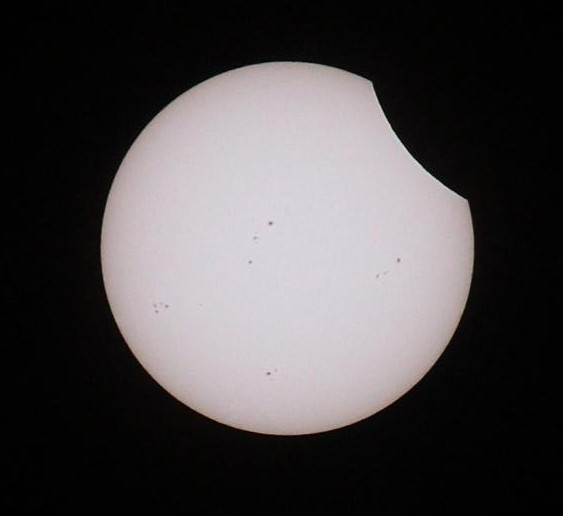
Image courtesy of
Long Room ,
modified slightly by MWR.
grows more dramatic over the next half hour or so (Rochester equivalent: about 2:55 PM; not sure if we'll see such nice sunspots, but there's a chance)
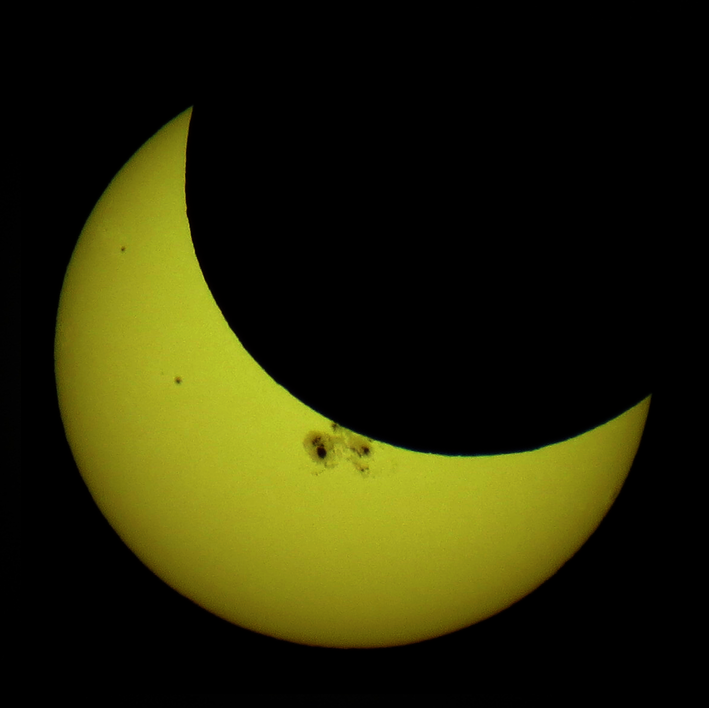
Image courtesy of
Wikipedia
As the shadow of the Moon approaches the viewer's location,
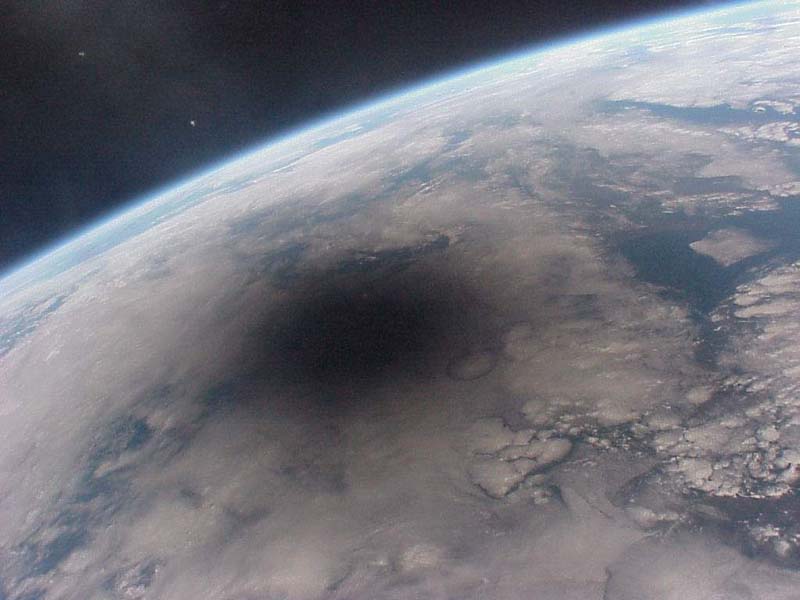
Image of
eclipse taken by cosmonauts in Mir in 1999,
courtesy of
Mir 27 crew
and
CNES
the skies will begin to darken.
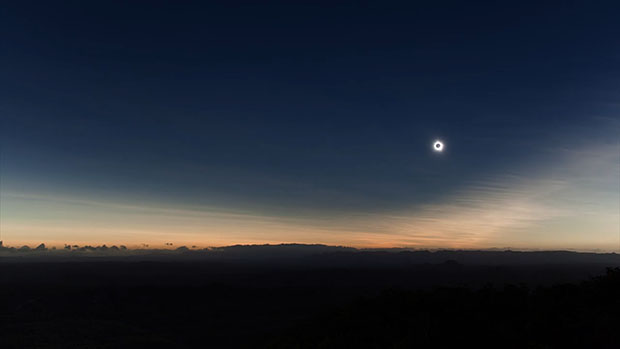
Image of Moon's shadow courtesy of
Colin Legg
As the very last little sliver of the solar atmosphere disappears, we may be lucky enough to see the "diamond ring" phenomenon (around 3:20 PM for Rochester).
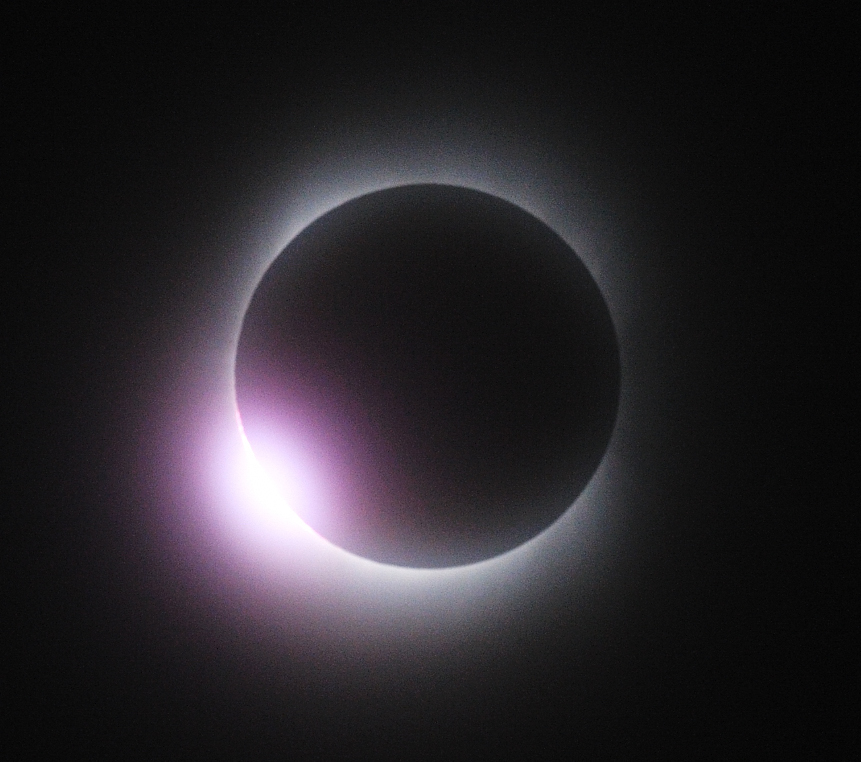
Image courtesy of
Kubotake and Wikipedia
and modified slightly by MWR
When the entire solar disk has been covered, the much fainter glow of the outer solar atmosphere -- the corona -- will pop into view.
Image courtesy of
Fred Espenek
Those with binoculars or telescopes may see a few solar prominences stick out beyond the limb of the Moon.
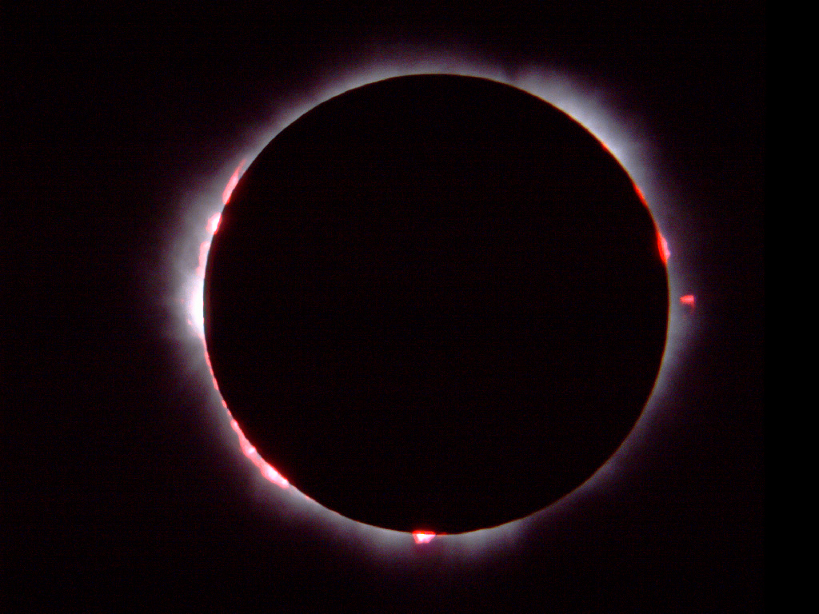
Image courtesy of
Bert Halstead
Stars and planets will become visible in the suddenly darkened sky.
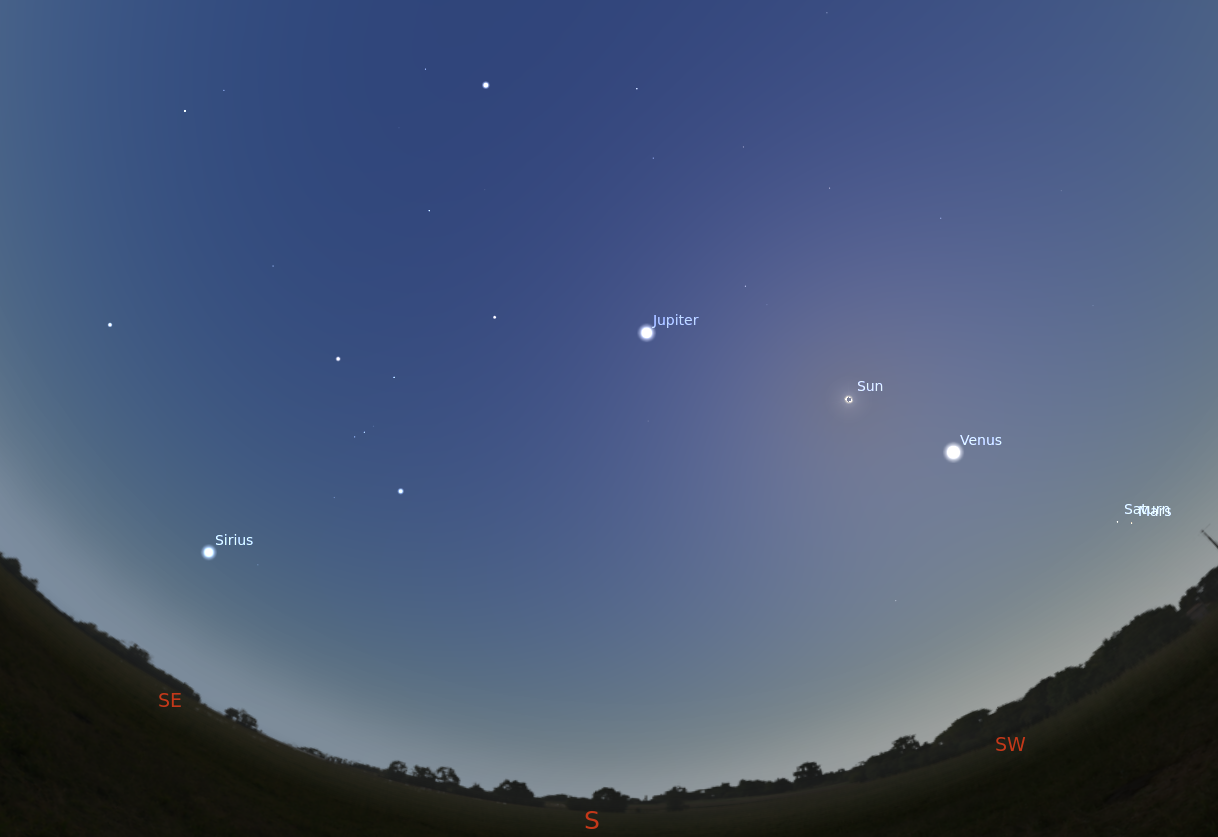
After just a brief time (222 seconds for us in Rochester), the Moon will begin to uncover the opposite side of the solar disk, and things will start to go back to normal.
The schedule for us in Rochester is (thanks very much to Xavier M. Jubier -- see his website for details!)
EDT PM
Start of partial eclipse (C1) 02:06:59
Start of total eclipse (C2) 03:20:06 (safe to take glasses off after this)
Maximum eclipse 03:21:56
End of total eclipse (C3) 03:23:46 (put glasses back on before this)
End of partial eclipse (C4) 04:33:24
"Shadow bands?" you may ask. "What are they?"
They are a mysterious, elusive phenomenon that appear just before, and just after, a total eclipse. Few people have seen them, and even fewer have recorded them clearly. Let me describe them indirectly, by starting with something more familiar.
Have you ever looked at the bottom of a swimming pool on a sunny day? If so, you've probably seen a lacy network of narrow bright lines, swaying and moving as waves move across the water's surface.
Image courtesy of
Wikimedia
These bands of light are created when sunlight passes through the uneven, wavy, air-water interface at the surface of the pool. Rays of light strike the water at slightly different angles from one place to another, causing the rays to bend this way or that as they move downward toward the bottom of the pool. Where several rays meet, we see bright lines. Scientists call these curvy bright lines caustics.
In a similar way, light rays from the Sun can be refracted by wavy variations in the Earth's atmosphere to create regions of brighter light on the surface of the Earth.
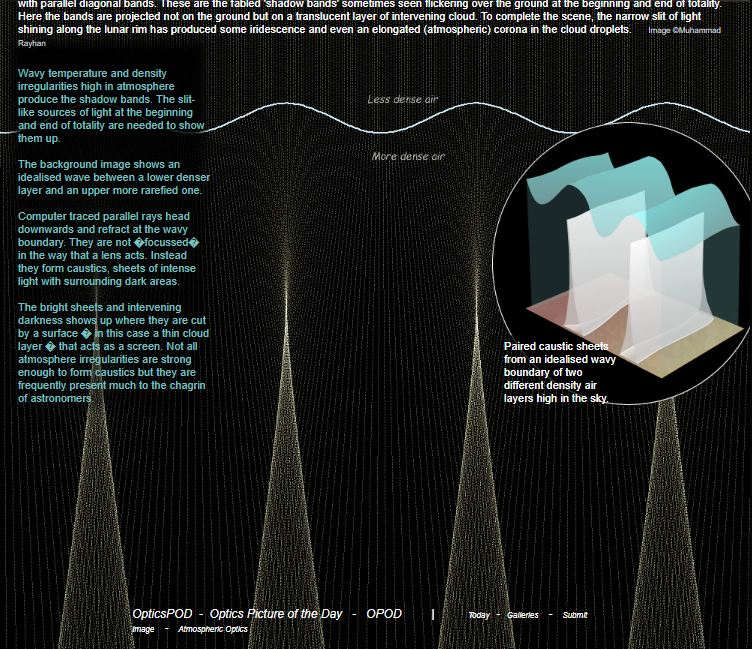
Image courtesy of Muhammad Rayhan and
Optics Picture of the Day
These extra-bright (and slightly less-bright) areas are completely unnoticable during ordinary situations. However, when the Sun is ALMOST completely covered by the Moon's disk, so that only a very thin crescent remains ...
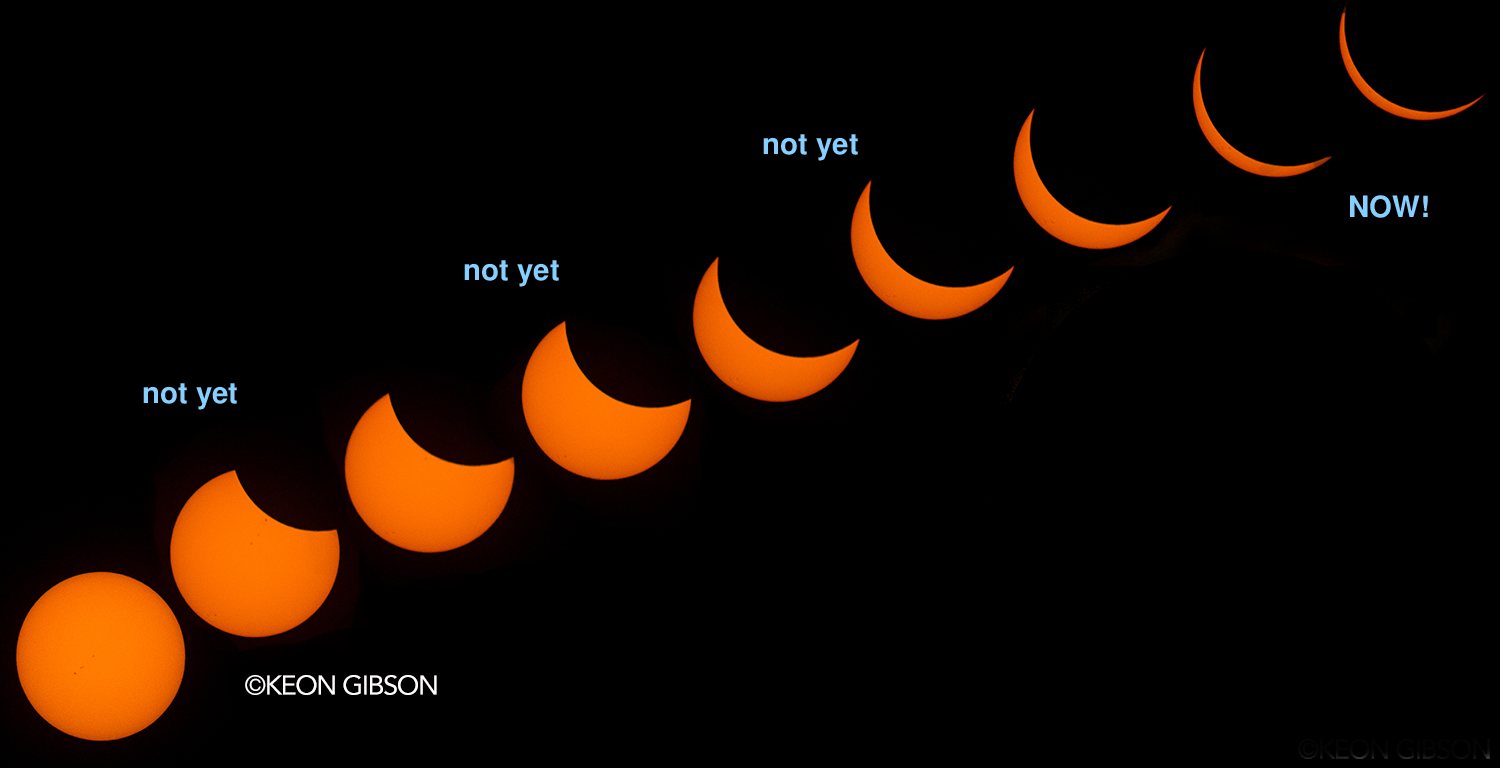
Image courtesy of
Keon Gibson and
NASA
... the shadow bands can sometimes be seen: ghostly, faint lines of white and grey. They appear to "fly" across the landscape at moderate speeds. One of the best videos showing these elusive bands was taken during an eclipse in 2019; click on the picture to activate. Notice how much sharper and distinct they become in the last minute before totality, and in the first minute after totality. Check out the section from about 1:00 to 2:10 in the video.
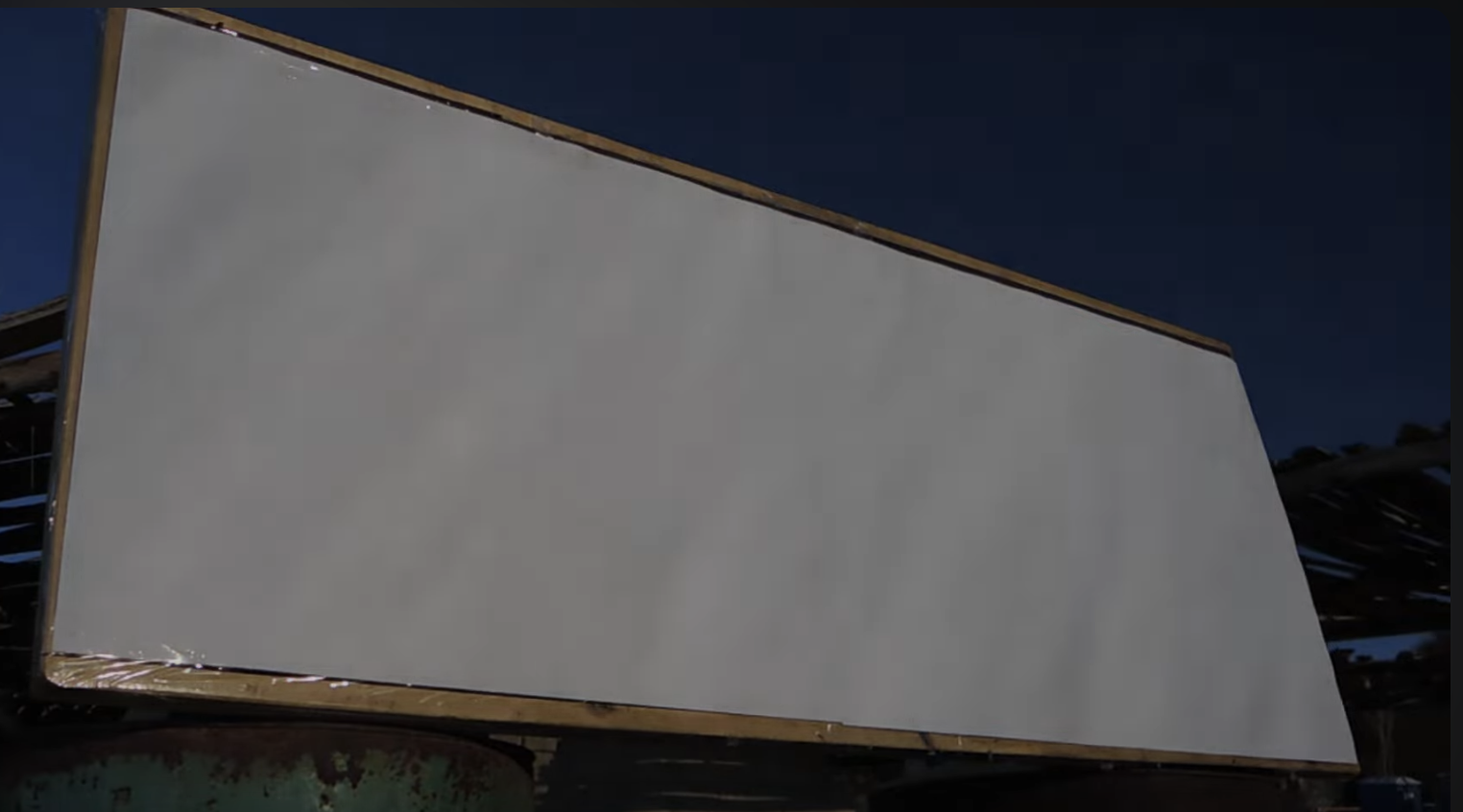
Image and movie courtesy of
Thierry Pauwels
(or local copy)
In order to see this phenomenon, choose your spot for viewing the eclipse carefully. Look for
Good luck!
As the Moon moves in its orbit around the Earth, the shadow it casts on the Earth moves with it. If one happens to be floating high above the planet in space, looking down, one will see the shadow slide across oceans and continents. Click on the picture below to see the Moon's shadow during a total eclipse in 2020.
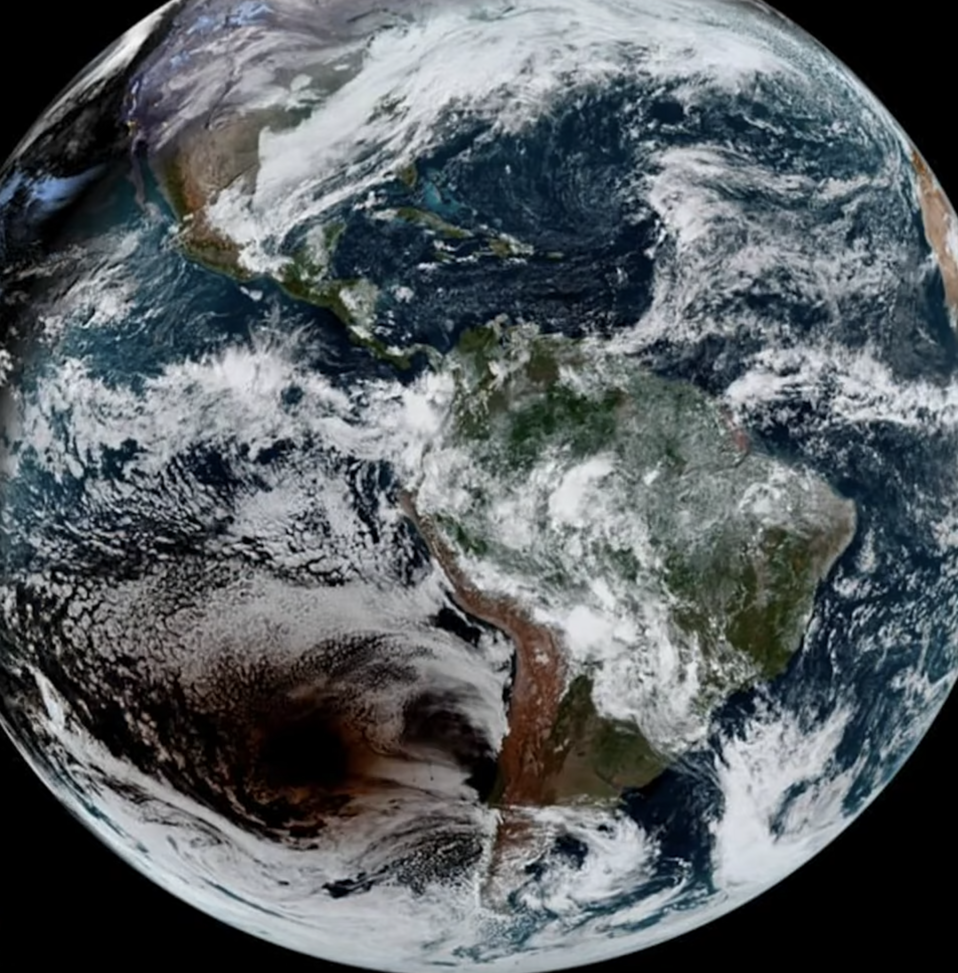
Image and video courtesy of
Video from Space.com
or
a local copy.
During our solar eclipse, on April 8, 2024, the shadow of the Moon will fly across North America from southwest to northeast, passing over Rochester, into Canada, and then over the North Atlantic.
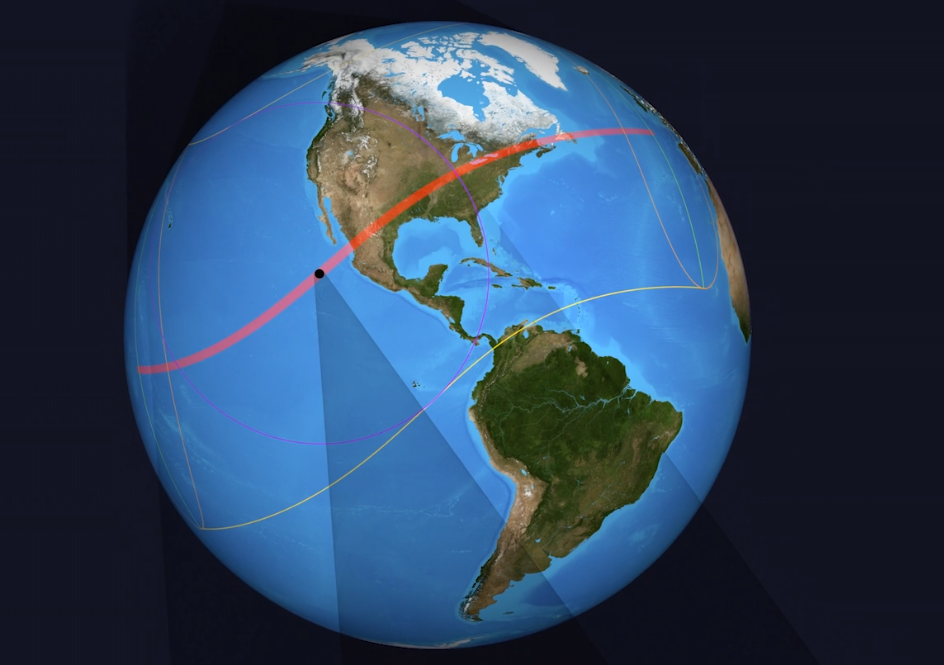
Animation courtesy of
NASA's Scientific Visualization Studio
or
a local copy.
Those of standing on the ground will see the shadow approaching from the southwest. Starting around 3:15 PM, the skies in that direction will start to darken. Within just a few minutes, day will turn into night.

Image and video of 2017 eclipse courtesy of
Michael Hopcroft
or
a local copy.
Here's another good example of the uncanny approaching, and then departing, shadow, with footage take by a drone hovering over Riverton, Wyoming, in 2017.
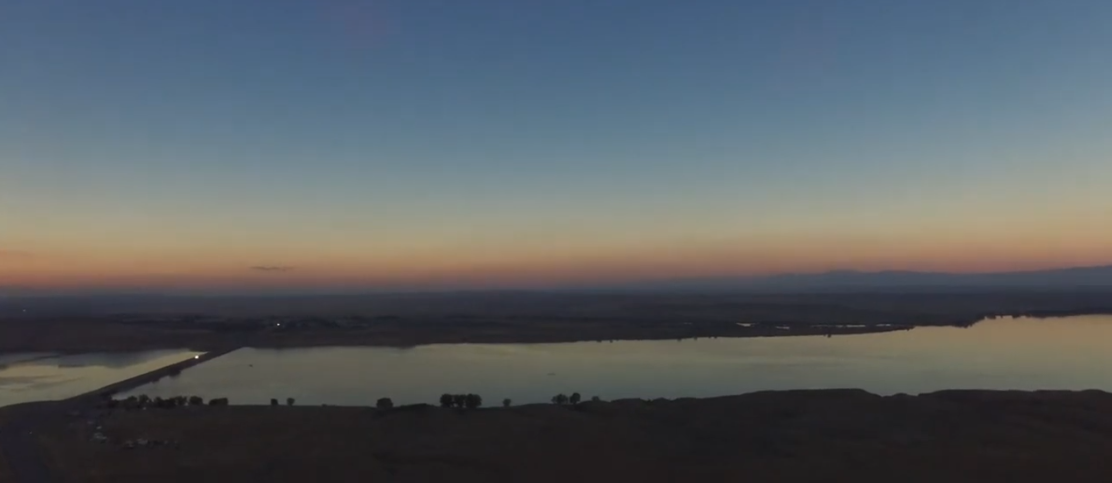
Drone footage of eclipse shadow in Riverton, Wyoming (2017)
thanks to
Cinclodes
or
a local copy.
The Moon circles the Earth every 29 days or so, changing from Full Moon to New Moon and back to Full as we see more or less of the sunlit portion of its globe. Every New Moon means that the Moon is passing between the Sun and Earth in its orbit -- so why don't we experience a solar eclipse once a month?
Warning, personal reminiscence approaching: At one point in my graduate school career, I was working on radio observations of planets. I attended a small meeting of people in the field in order to discuss the use of solar system bodies as flux calibrators. During our conversations, a post-doc who had built a very detailed thermal model of planetary emission warned us that the Moon would be a poor choice for a target "because it cools off every month during the lunar eclipse." I was surprised that only one other person at the meeting had the same "Wh--- wait a minute!" reaction as I.
The answer lies in the tilt of the Moon's orbit around the Earth. (Click on the image below to activate applet)
The diagram above -- like most one can find describing eclipses -- does not show the Earth and Moon properly to scale with the separation between them. A more accurate view of the situation can be seen in the animation provided by NASA's Scientific Visualization Studio. (Click on the image below to activate applet)
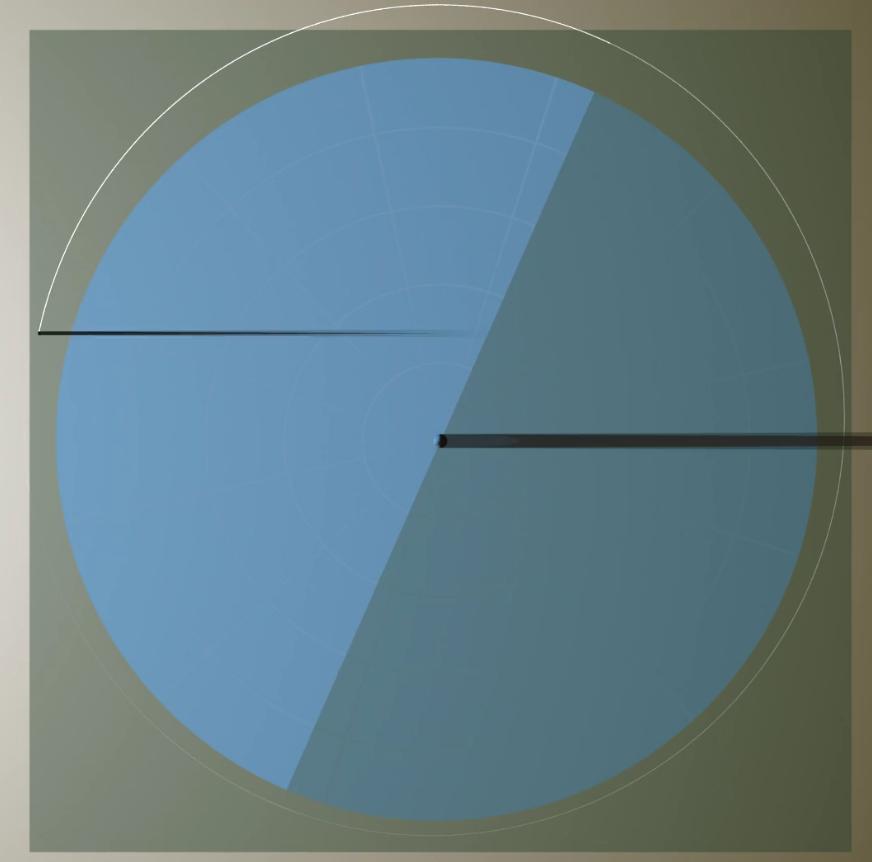
Animation courtesy of
NASA's Scientific Visualization Studio
In general, out of the roughly 13 New Moons every year, only 2 have the possibility of crossing directly in front of the Sun and causing a solar eclipse; and on those occasions, the shadow may cross the very top (Arctic) or bottom (Antarctic) of the globe, disappointing pretty much all humans.
The bottom line is, solar eclipses aren't very common, period. Moreover, since the Earth is a big place, the chances that one of these rare events happens in any particular vicinity is small. For example,
Q: How many solar eclipses will touch SOME part
of the United States between the years 2000
and 2050?
A: 10 -- but only 3 really good ones
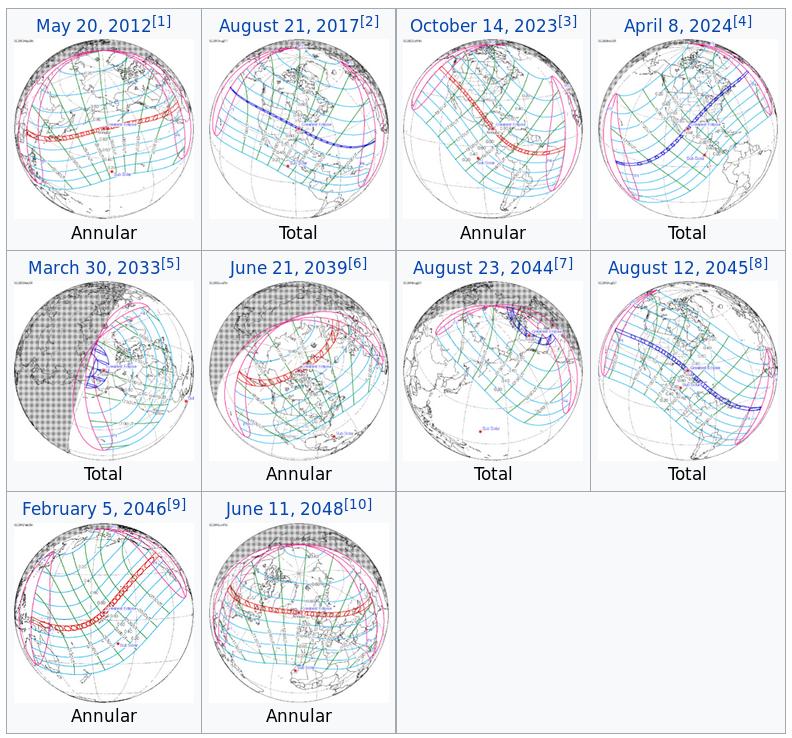
Maps courtesy of
Wikipedia and Fred Espenak, NASA's GSFC
Now, why do I only count 3 of these as "good" eclipses? In part due to the tiny portions of the US which fall into the path of totality in some cases, but mostly due to the difference between total and annular eclipses. Only total eclipses are really "good" ones, in my opinion.
The difference is caused by the eccentricity of the Moon's orbit, which is NOT a perfect circle. At perigee, the Moon is closer-than-average to the Earth, and so it appears larger -- but at apogee, the Moon is farther-than-average, and so appears smaller.
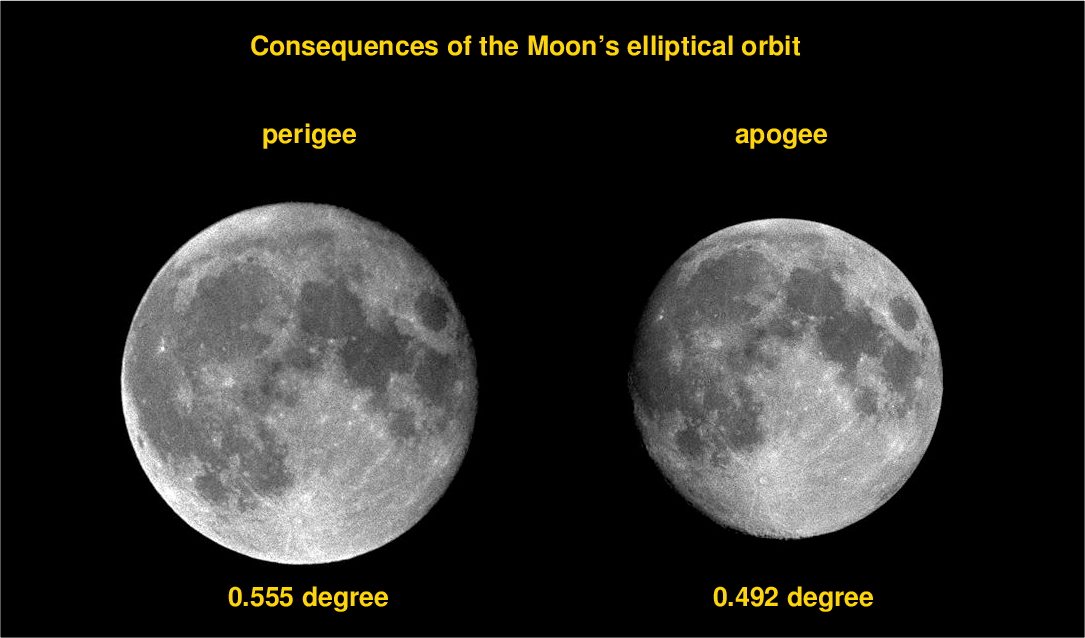
Images of the Moon courtesy of
John Walker
Perhaps examples showing the gradual change in size of the lunar disk over the course of a few months might help to make this clear. Click on the image below to activate a short movie showing the Moon's appearance during September, 2005: (Click on the image below to activate animation)
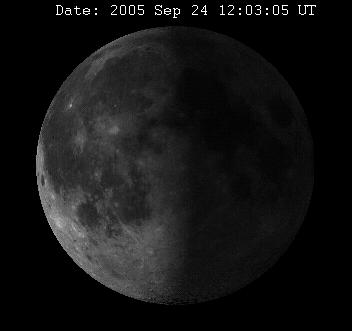
Image courtesy of
Tom Ruen
and
Wikipedia
This difference is not huge -- but it is large enough to make a big difference to people watching from the Earth. The Sun's average angular diameter lies right between these two extremes, at about 0.53 degrees. That means that when the Moon is at perigee, it will completely cover the solar disk ... but not when it is at the most distant point of its orbit. If a solar eclipse occurs while the Moon is near apogee, observers will see a bright ring of sunlight circling the black lunar disk.
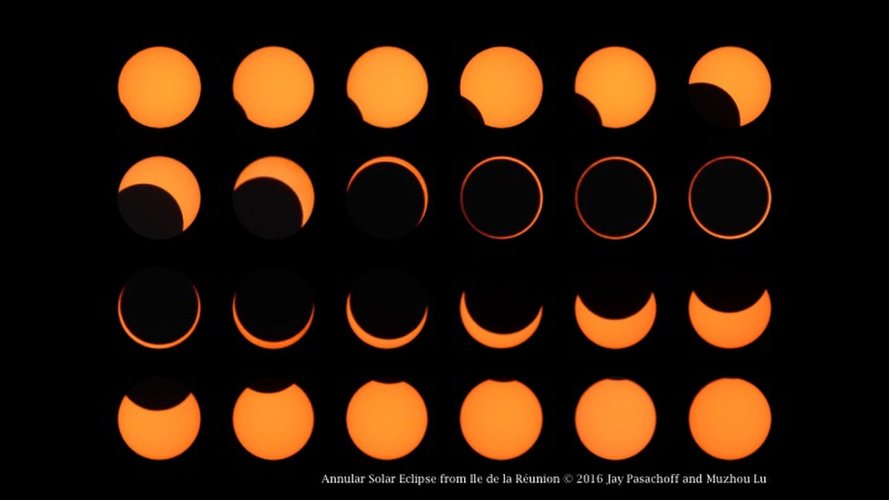
Images courtesy of
Jay Pasachoff and space.com
The changing distance between Earth and Moon explains why this eclipse -- in 2024 -- will be more impressive than the one which crossed the United States in 2017. Back then, the Moon was a bit farther away from the Earth, making its shadow a bit smaller. In 2024, the shadow will be wider, allowing more people to watch the eclipse and giving all of us an extra minute or two of totality.
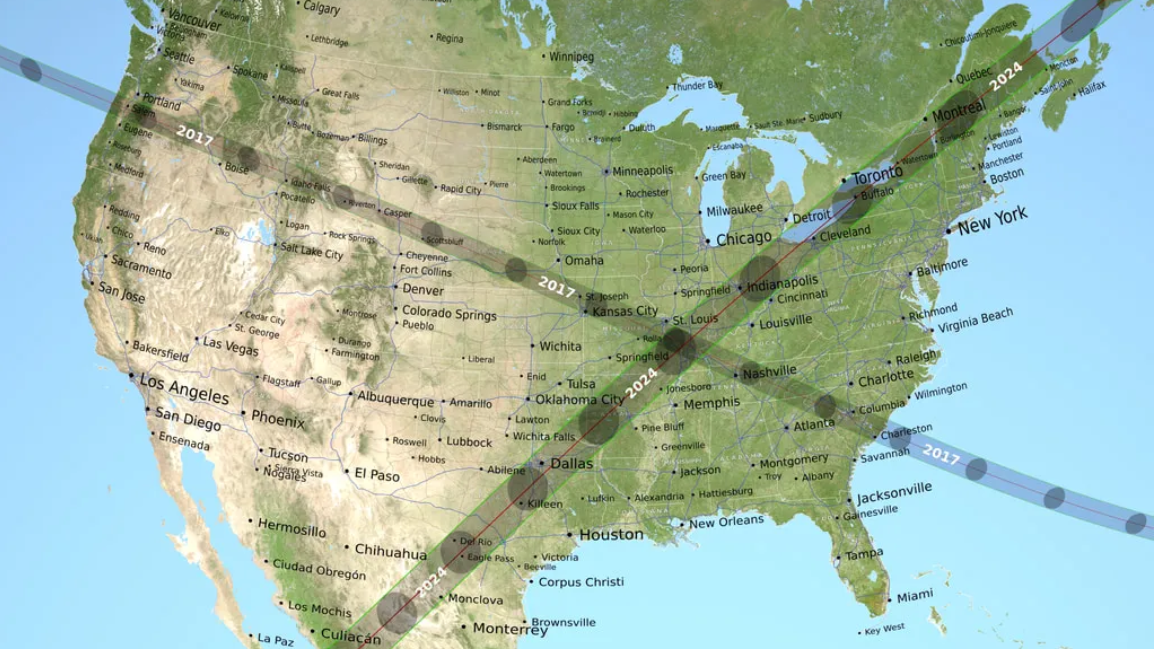
Image courtesy of
Ernest Wright/NASA's Scientific Visualization Studio
We humans have evolved at a fortunate time: we figured out how to predict the motions of the Sun and the Moon in the sky, and how to build telescopes and cameras, just when the Sun and Moon are the right sizes to create "perfect" solar eclipses: events during which the Moon just barely covers the solar disk. This almost exact match in angular size leads to dramatic effects, like this:

Image of Bailey's Beads courtesy of
Fred Espenek
But the Sun and Moon won't always appear to be the same size, as viewed from the Earth ... which means that these wonderful eclipses will soon (geologically speaking) disappear.
It's partly the Sun's fault. As the hydrogen in the Sun's core fuses into helium, the temperature and density of the core gradually change; the net effect is that the amount of energy generated each second very gradually increases. Through a complex set of mechanisms, the changes in the core cause the Sun slowly to increase in size. (Click on the image below to activate applet)
As the Sun grows bigger, it becomes difficult for the Moon to cover it completely.
But that's not all. The Moon is to blame, too. The Moon and Earth distort each other slightly via their mutual gravitational pull, creating small elliptical bulges in each (which we experience directly as the tides of the Earth's oceans). Now, the Earth's bulges spin around quickly, taking just 24 hours (yeah, yeah, 23 hours 56 minutes 4 seconds relative to the stars) to make one revolution. That's much faster than the Moon's orbital period of about 27 days. The gravitational forces of the quickly-spinning Earth's bulges transfer energy and angular momentum to the slowly-spinning Moon's bulges, causing
For our current discussion, the important point here is that the Moon is slowly moving away from the Earth.
How do we know for sure? If we construct special optical devices called "retro-reflectors"
and place a bunch on the lunar surface
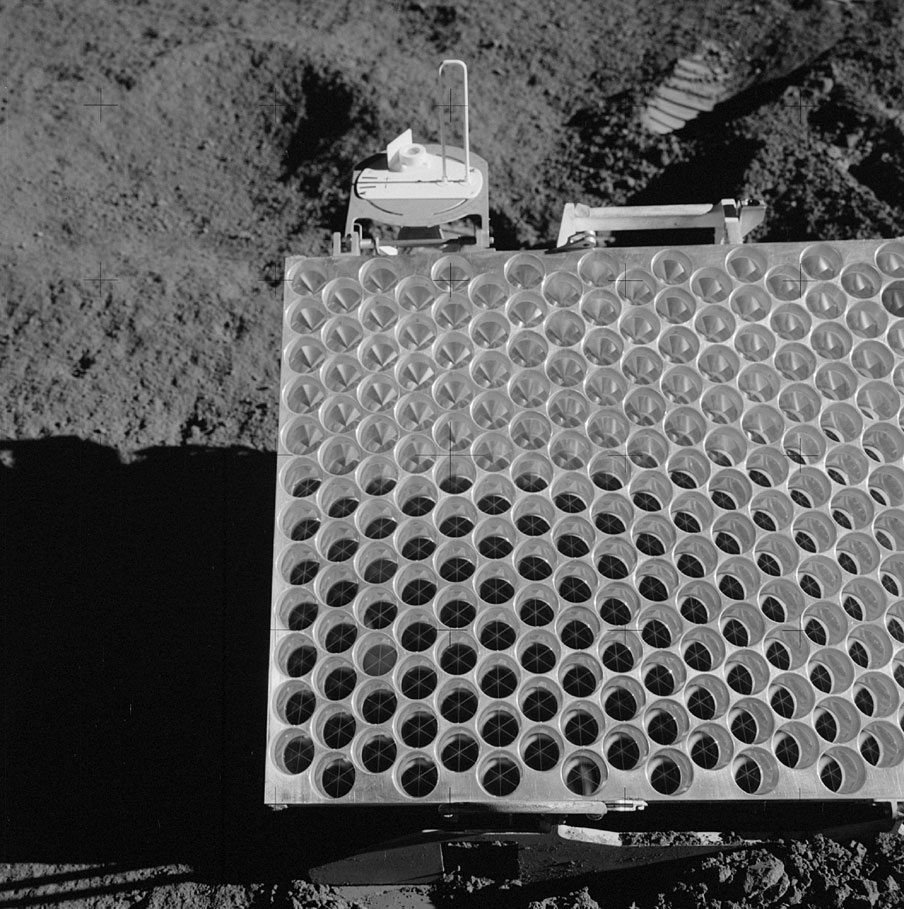
then shine a REALLY STRONG LASER at those reflectors and wait for the photons to bounce off and return
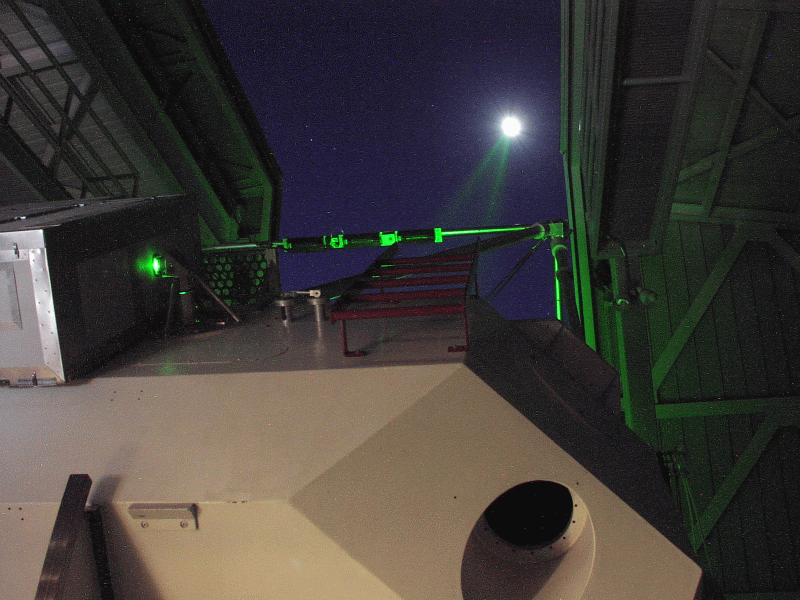
Image of APOLLO laser-ranging system on the 3.5-meter
Apache Point Telescope courtesy of
the APOLLO project
then we can measure the distance between the Moon and Earth to a precision of a few millimeters. Scientists who have monitored this distance over the past few decades have measured an average recession of
Q: How far does the Moon recede from the Earth each year?
A: 3.8 cm per year
That doesn't sound like much -- and it isn't, on human timescales. But given enough time, this tidally-driven recession can increase the Moon's distance significantly. And, of course, as the Moon recedes from the Earth, it appears to shrink in size.
So, if we put together these two effects -- the Sun's outer atmosphere expanding, and the Moon gradually receding from the Earth -- we can foresee the end of total solar eclipses.
The figure below is slightly changed from the original version of this talk. The original assumed a fixed value of the Earth's orbital eccentricity of its current value, e=0.0167. But the Earth's orbital eccentricity varies periodically due to perturbations by other planets. The figure below adopts a fixed value, e=0.058, which corresponds to the largest value in this periodically varying eccentricity.
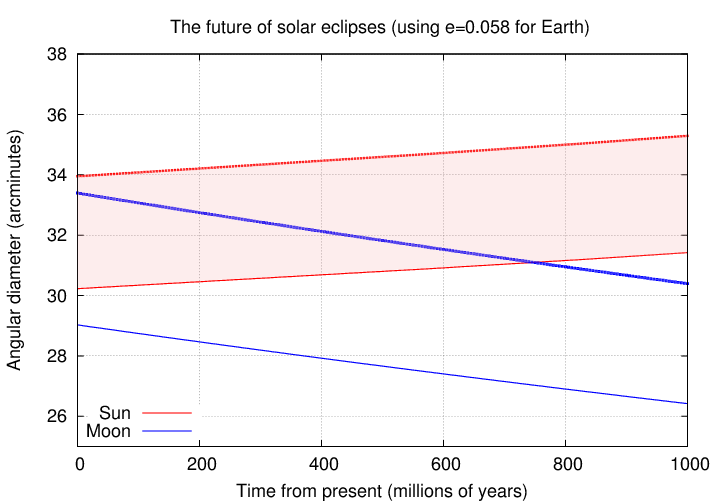
In about 750 million years, the Moon will no longer, even under the best of circumstances, be able to cover the Sun's disk completely. Eclipses will still occur, but those watchers of the future will experience only partial eclipses; their eyes will never see the corona shining faintly around the black circle of the Moon.
As you can see, it takes a rather special combination of a moon's size and distance from its host to create a perfect, just-barely-covers-the-Sun eclipse. We humans, on Earth, right now, have the opportunity to experience such "perfect" eclipses.
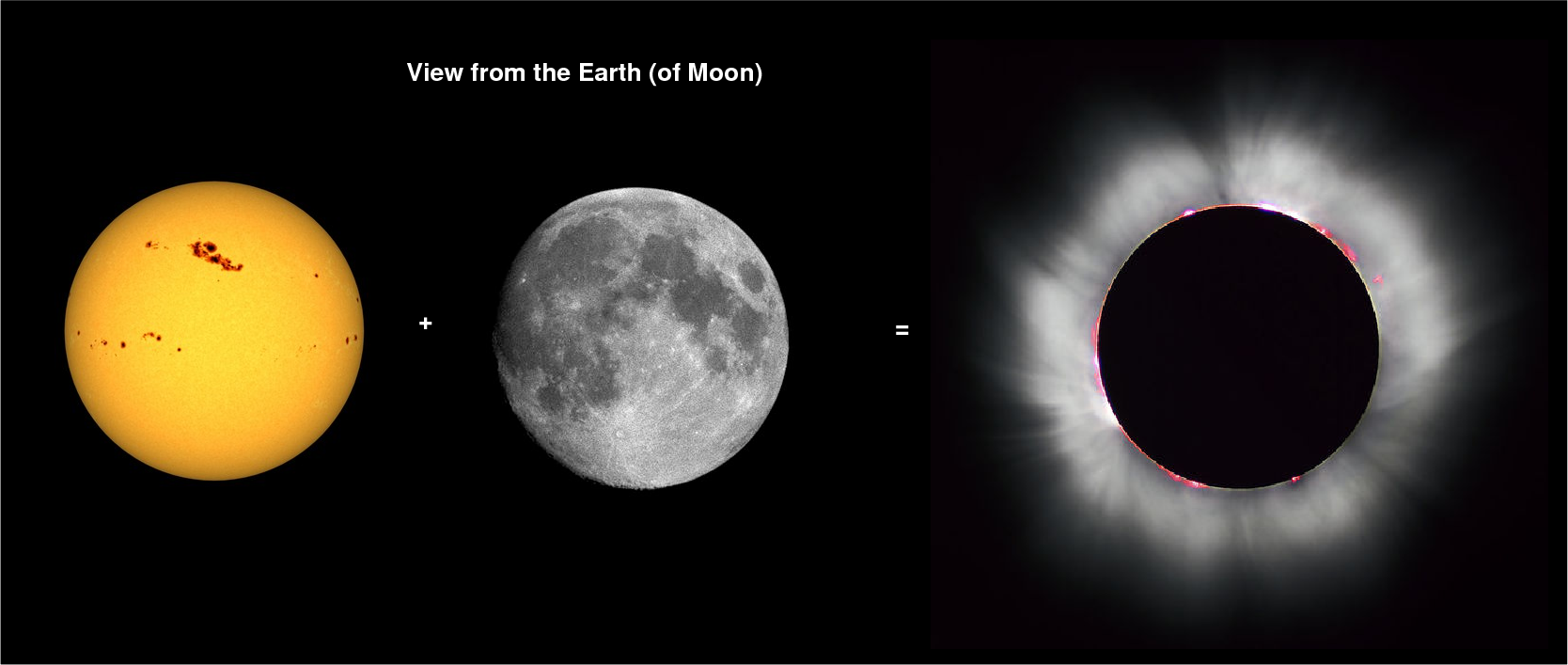
Image of Sun from
Georgia State University Dept. of Geosciences ;
image of Moon from
John Walker ;
image of eclipse from
Luc Viator and Wikipedia
But what about people (or creatures) elsewhere in our Solar System?
You may have read The Earth is the only planet from which one can see total solar eclipses -- but is that true?
Well, let's start by asking:
Q: How many of the planets in our Solar System have moons?
The answer is .... 7
Earth 1 (Moon) Mars 2 (Phobos and Deimos) Jupiter 95 (recognized by the IAU) Saturn 146 (as of June 8, 2023) Uranus 27 (very literary) Neptune 14 (Triton plus many smaller) Pluto 5 (Charon plus four smaller)
For more information on these numbers, check out NASA's webpages for Jupiter Saturn Uranus Neptune Pluto
Now, one can go through a list of all the moons and their orbital properties and their physical properties to compute the angular size of each moon (as seen from its parent planet), then compare that to the angular size of the Sun. Plenty of moons appear much larger than the Sun, and even more appear much smaller. But very few are even close to the right size to just barely cover the Sun's disk.
For example, consider Mars. Its larger moon, Phobos, is not quite large enough (or quite close enough to Mars) to cover the entire disk of the Sun.
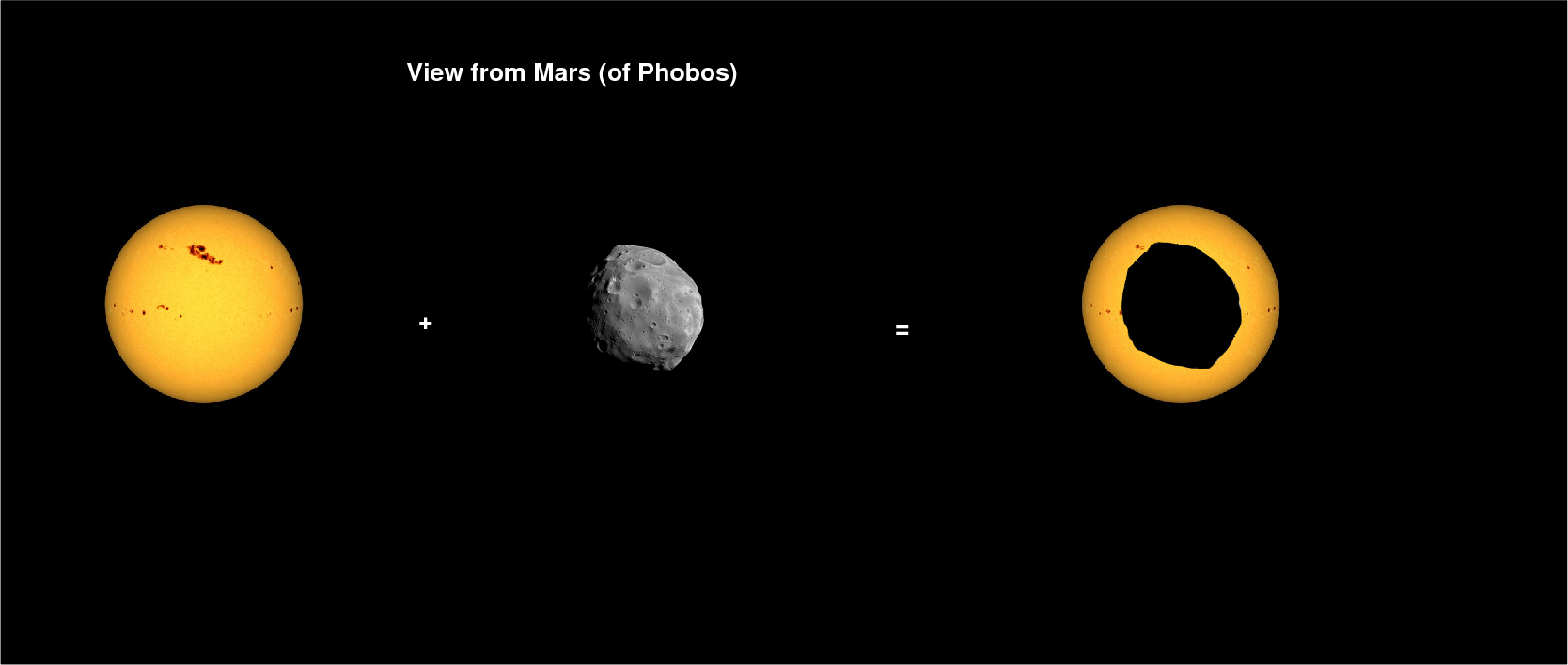
Image of Sun from
Georgia State University Dept. of Geosciences ;
image of Phobos from
ESA/DLR/FU Berlin (G. Neukum) ;
image of eclipse from
Luc Viator and Wikipedia
In this particular case, you don't have to believe my calculations; you can examine a photograph of a real transit of Phobos, as seen by the Curiosity rover on the Martian surface!
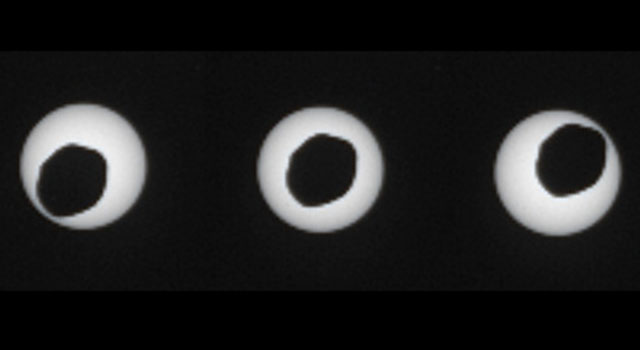
Image and movie courtesy of
NASA/JPL-Caltech/Malin Space Science Systems/Texas A&M Univ.
There's also a very nice movie showing a different transit of Phobos.
So, Mars fails. And, according to my calculations, the other planets do, too. Although both Jupiter and Saturn do have moons which appear to have nearly the same angular size as the Sun, those moons are small enough that they have lumpy, elongated shapes; instead of covering the solar disk perfectly, they will always leave visible gaps and portions of the bright solar disk, which will overwhelm the fainter corona.
Jupiter's moon Amalthea, the best case among other planet-moon combinations, would produce an "eclipse" like this:
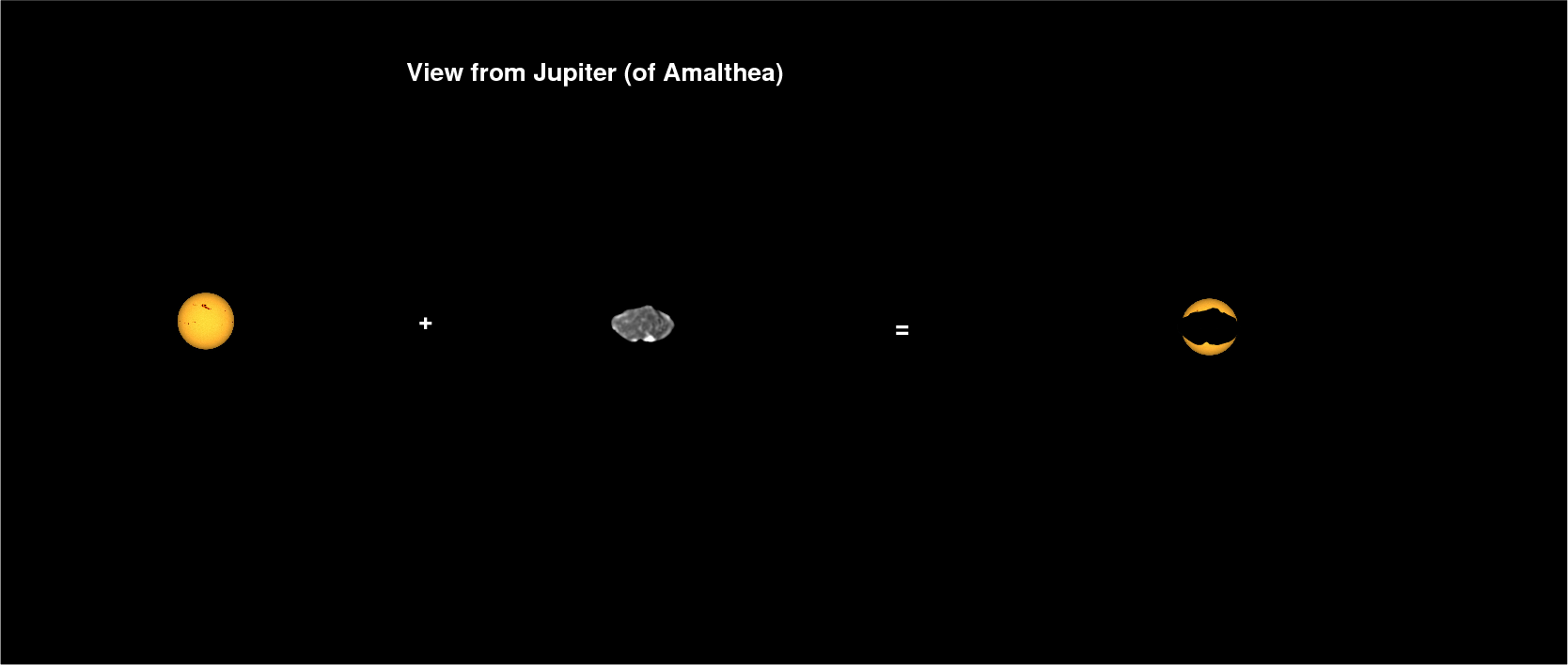
Image of Sun from
Georgia State University Dept. of Geosciences ;
image of Amalthea from
NASA/Galileo and Wikipedia
image of eclipse from
Luc Viator and Wikipedia
So, perhaps the claim that "the Earth is the only PLANET from which one can see a perfect solar eclipse" might be true ...
BUT
... it is not the only BODY from which one can see a perfect solar eclipse! Consider the inner Jovian system, containing Jupiter's four large moons: Io, Europa, Ganymede, and Callisto. When Callisto is near the antisolar point of its orbit, and the other moons are on solar side of theirs ...
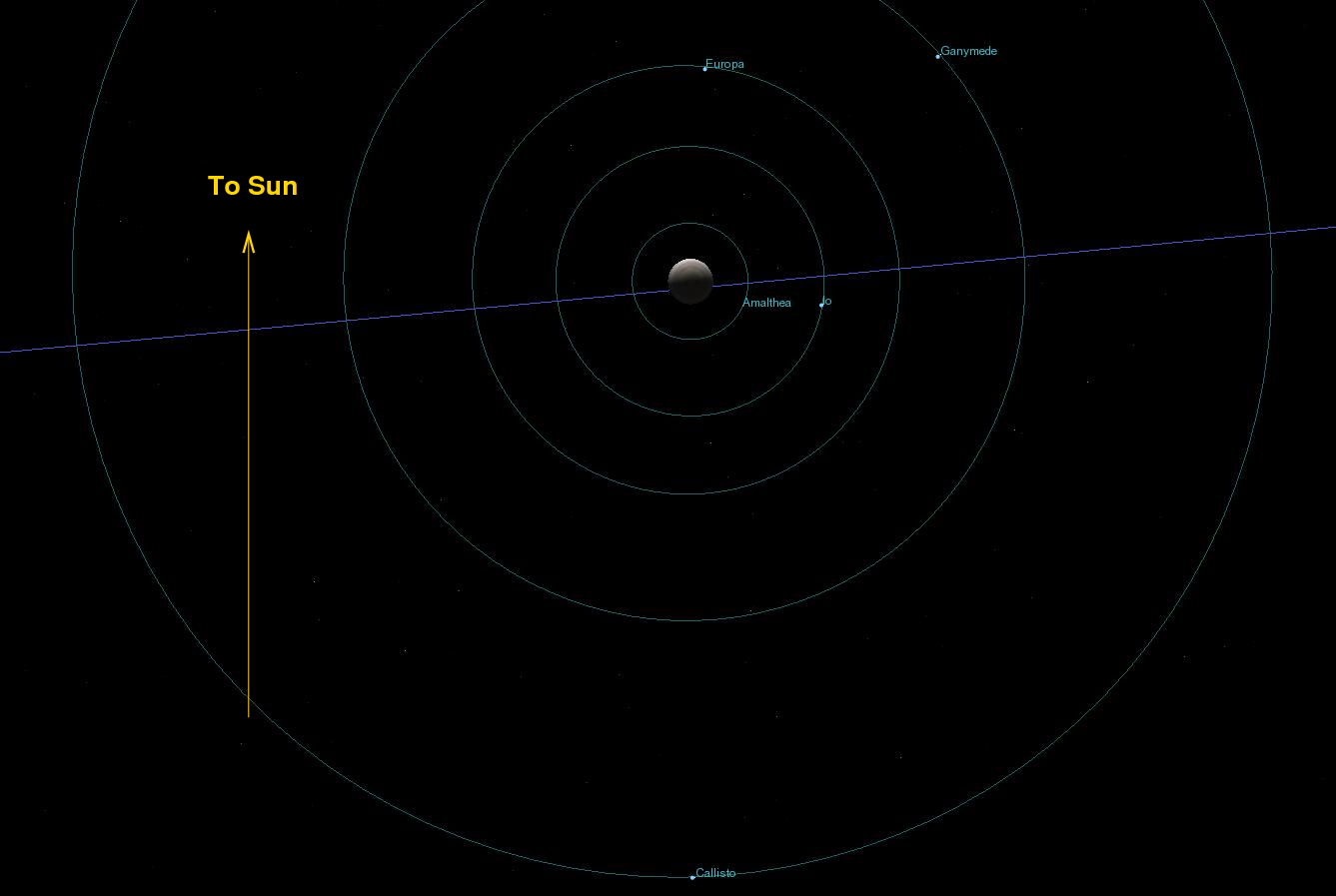
then, at a certain point in their orbits, those moons will appear just the same angular size as the Sun. If the timing is right, an observer standing on Callisto will see a "perfect" solar eclipse.
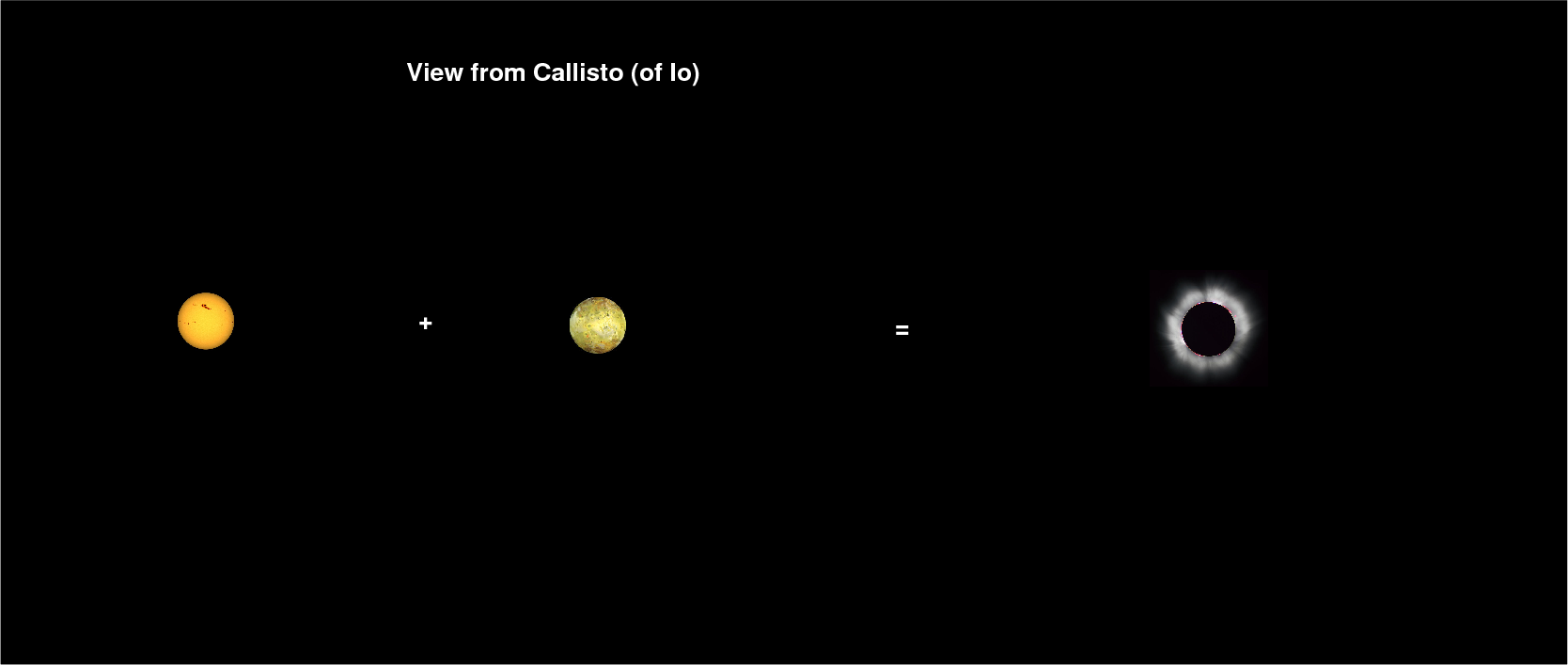
Image of Sun from
Georgia State University Dept. of Geosciences ;
image of Io from
NASA/Galileo and Wikipedia
; image of eclipse from
Luc Viator and Wikipedia
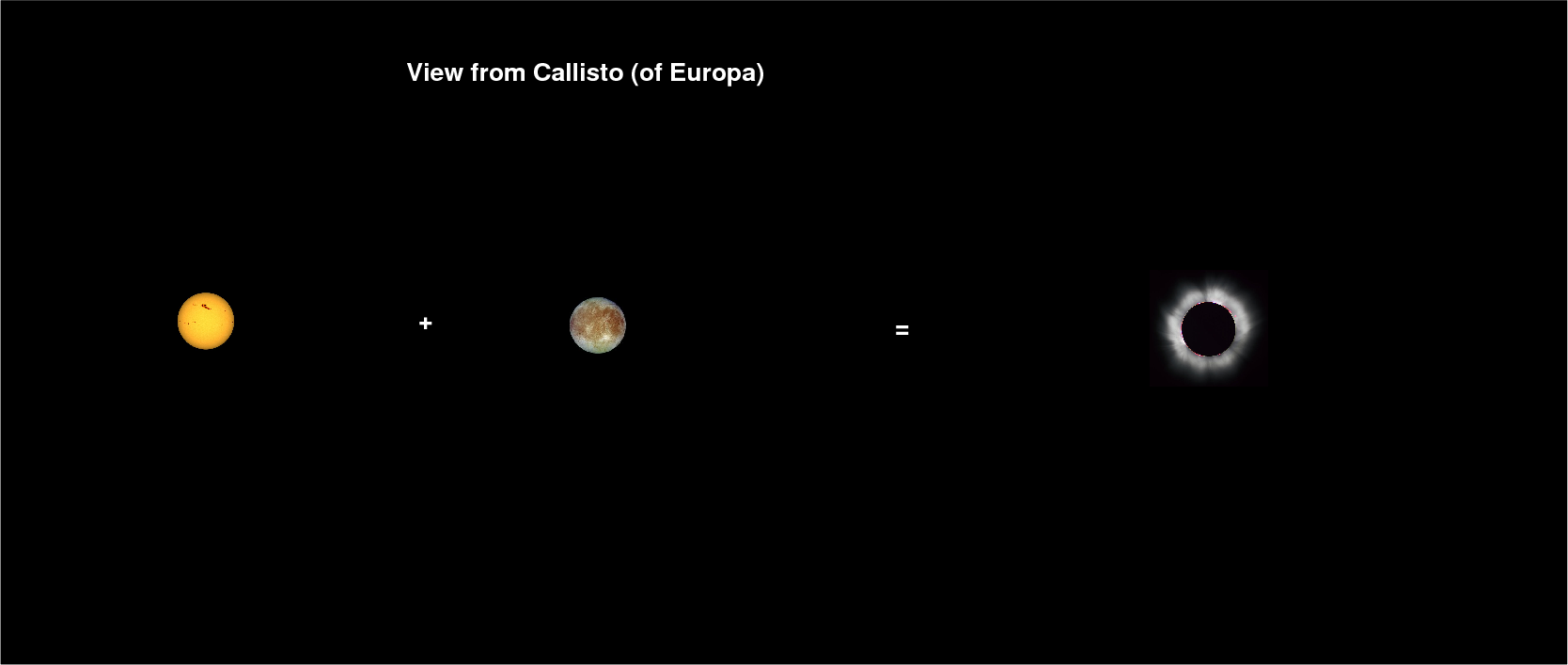
Image of Sun from
Georgia State University Dept. of Geosciences ;
image of Europa from
NASA/Galileo and Wikipedia
; image of eclipse from
Luc Viator and Wikipedia
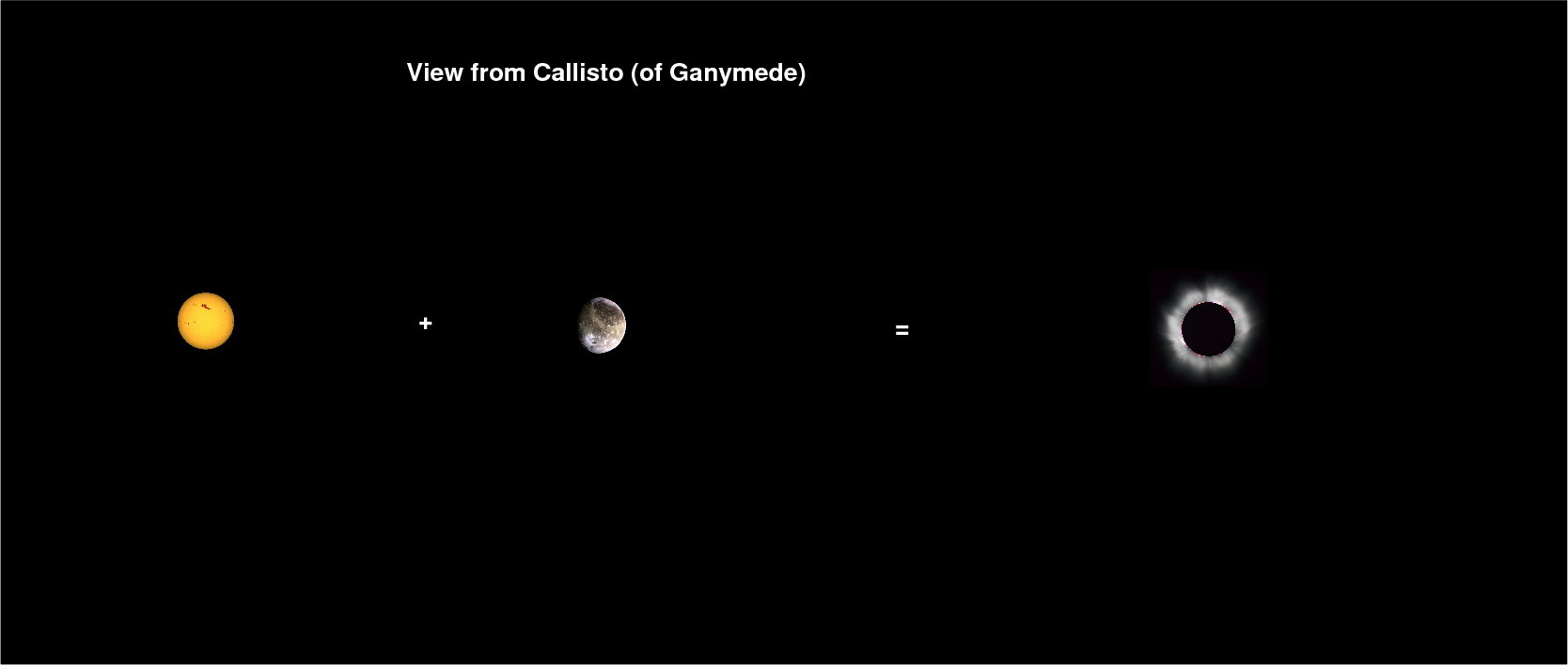
Image of Sun from
Georgia State University Dept. of Geosciences ;
image of Ganymede from
NASA/Galileo and Wikipedia
; image of eclipse from
Luc Viator and Wikipedia
Conversely, when Ganymede is near the antisolar point of its orbit, and Callisto is on the solar side of Jupiter, viewers on Ganymede may see Callisto block out the Sun.
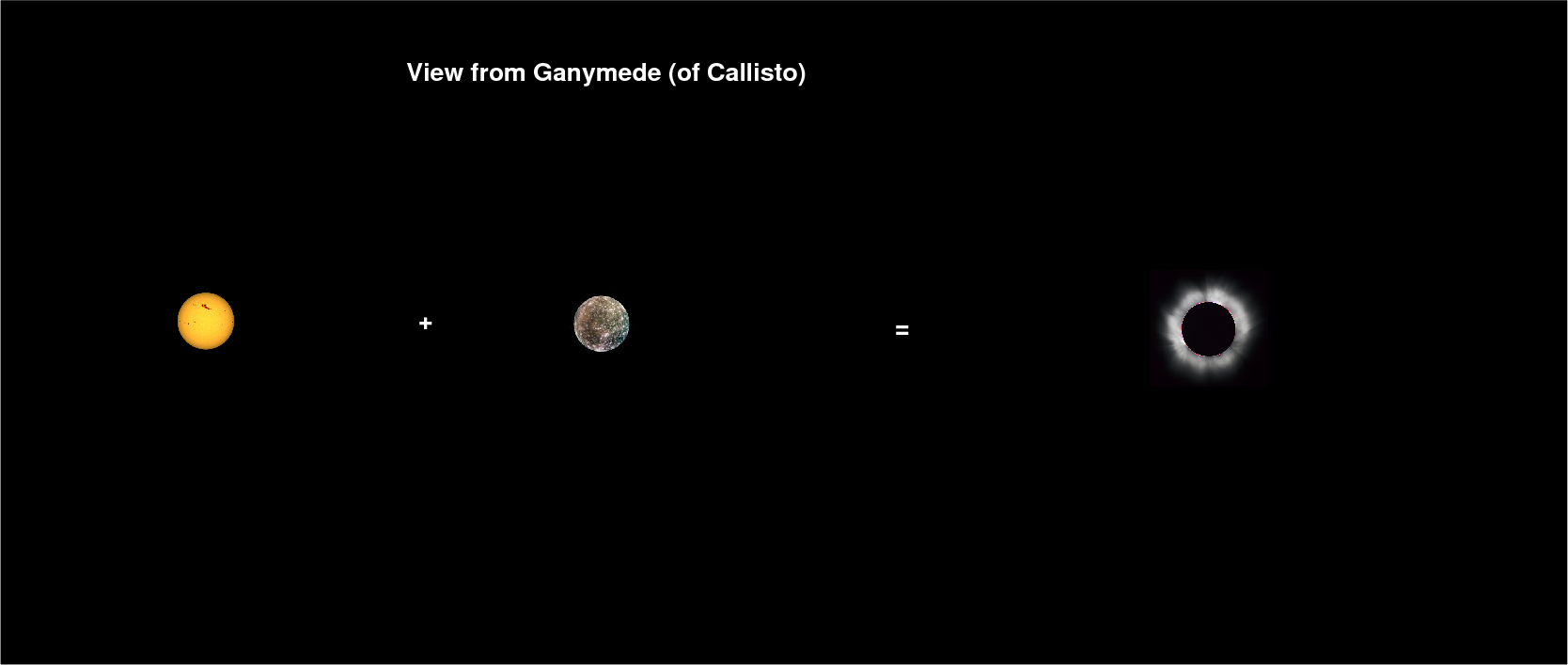
Image of Sun from
Georgia State University Dept. of Geosciences ;
image of Callisto from
NASA/Galileo and Wikipedia
; image of eclipse from
Luc Viator and Wikipedia
But Jupiter isn't the only planet to have lots of (relatively large) moons. Saturn has a bunch of its own. In this system, both Titan (look at outer orbits) and Tethys (look at inner orbits) can serve as a viewpoint.
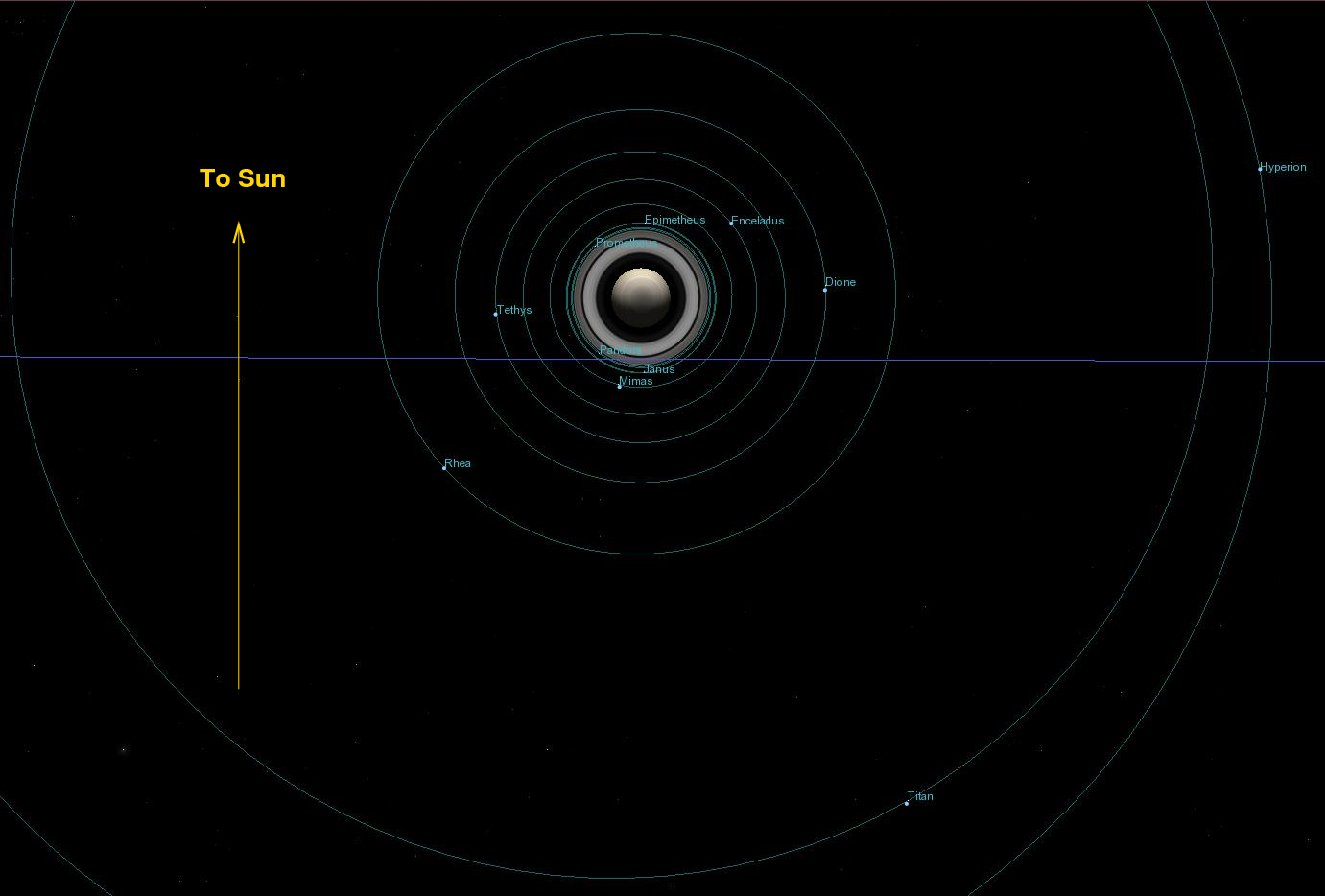
For example, a viewer on Tethys, looking at the "Death Star" of Mimas, may be lucky enough to see an eclipse:
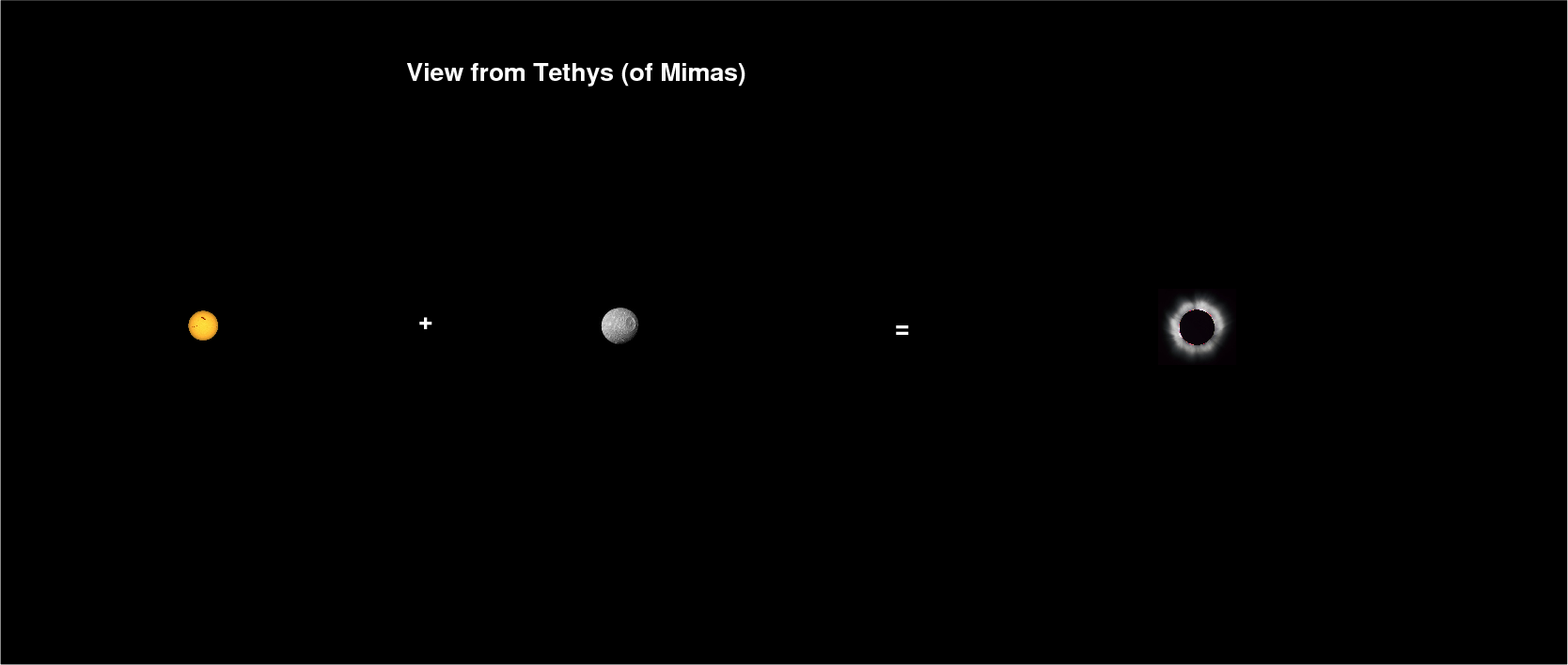
Image of Sun from
Georgia State University Dept. of Geosciences ;
image of Mimas from
NASA/Cassini and Wikipedia
image of eclipse from
Luc Viator and Wikipedia
And there are four other possibilities:
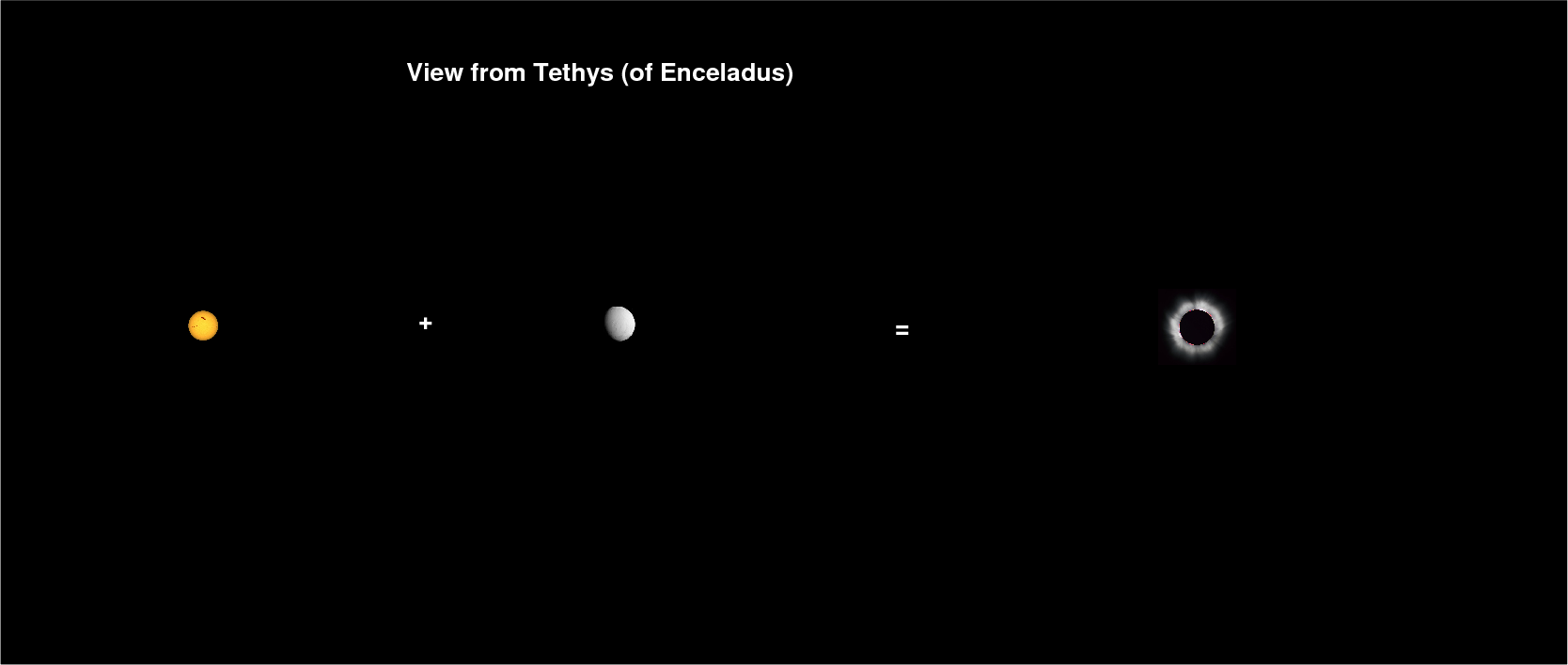
Image of Sun from
Georgia State University Dept. of Geosciences ;
image of Enceladus from
NASA/Cassini and Wikipedia
image of eclipse from
Luc Viator and Wikipedia
Tethys itself can act as the sun-covering object when viewed from Titan:

Image of Sun from
Georgia State University Dept. of Geosciences ;
image of Tethys from
NASA/Cassini and Wikipedia
image of eclipse from
Luc Viator and Wikipedia
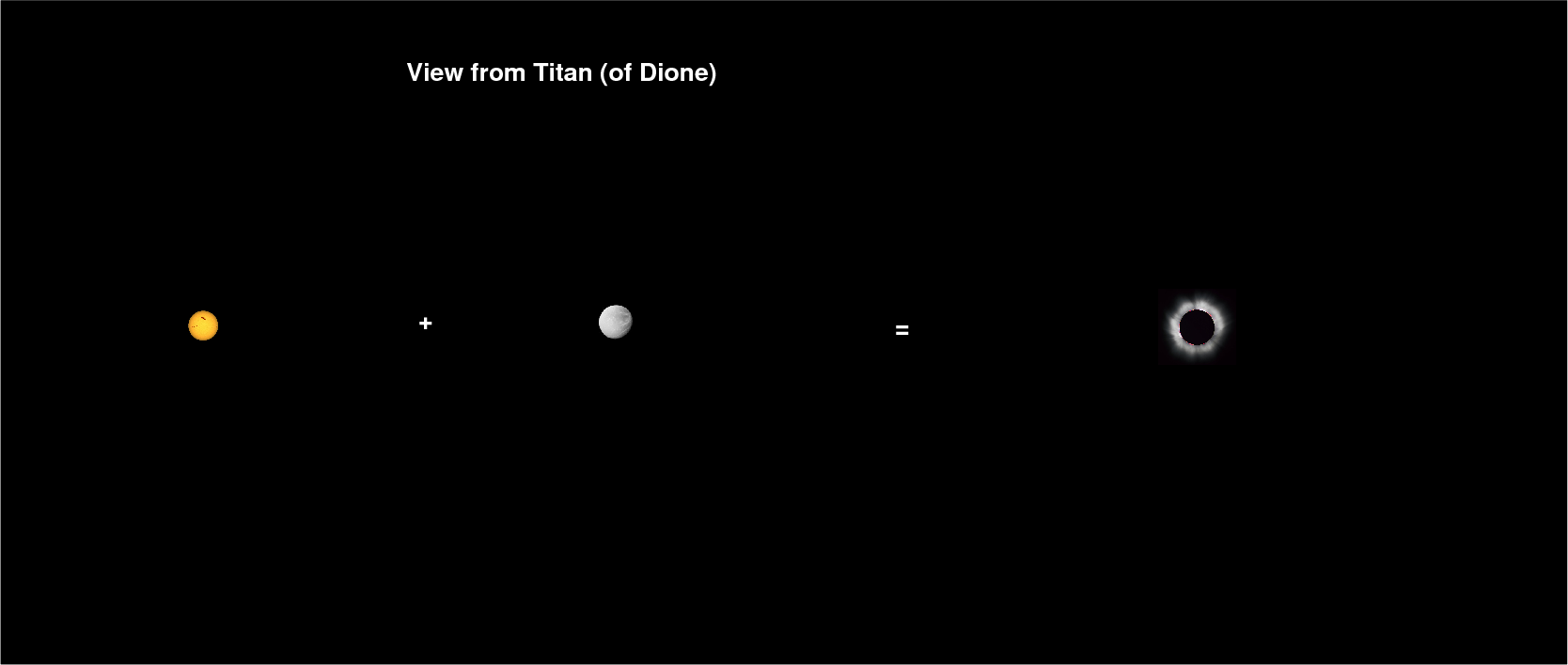
Image of Sun from
Georgia State University Dept. of Geosciences ;
image of Dione from
NASA/Cassini and Wikipedia
image of eclipse from
Luc Viator and Wikipedia
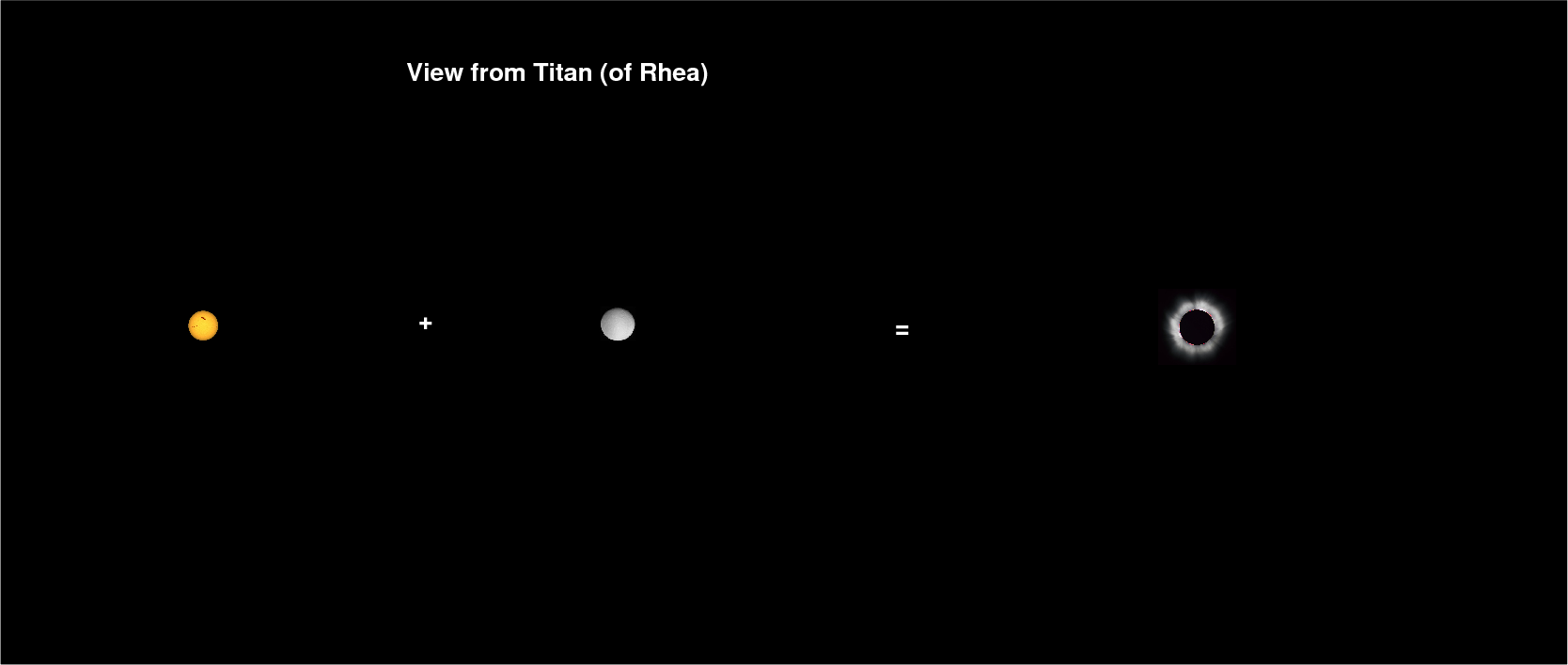
Image of Sun from
Georgia State University Dept. of Geosciences ;
image of Rhea from
NASA/Cassini and Wikipedia
image of eclipse from
Luc Viator and Wikipedia
The planets Uranus and Neptune lack enough large, spherical moons to present any good eclipse combinations. Pluto's moon Charon is way too big, and little Hydra (and the others) is way too small. As far as I can tell, those shown above are the only possibilities.
If you are interested in this idea of "moon-moon" eclipses, take a look at my list of all the possibilities in the Solar System.
Of course, because the Earth is much closer to the Sun than the Jovian and Saturnian systems, the solar eclipse seen from Earth is just plain larger and more impressive. Look!
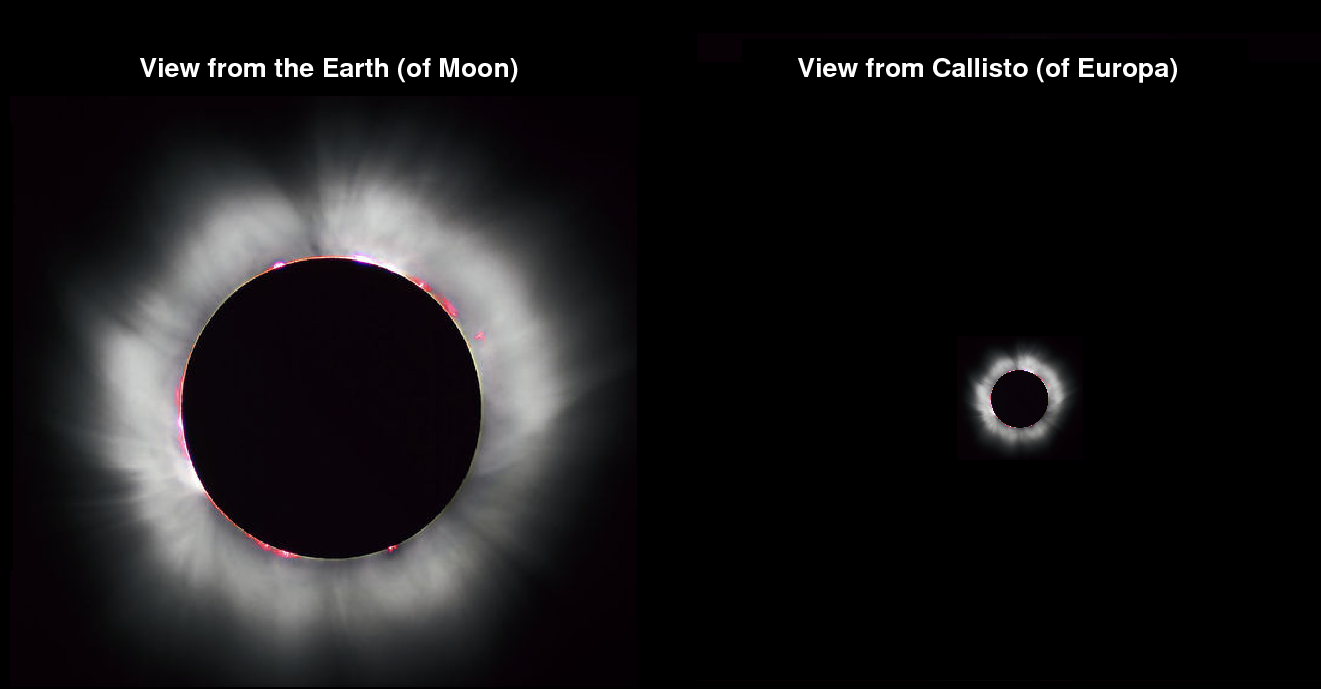
Image of eclipse from
Luc Viator and Wikipedia
The short version is pretty simple:
Don't look directly at the Sun unless it is fully covered by the Moon.
There are two reasons why eclipses can be dangerous to human vision.
This combination of factors means that people MIGHT try look at the Sun long enough for the visible and ultraviolet radiation to damage their vision. An example of solar retinopathy (yes, it happens frequently enough that it has its own name) is shown below. The lower panel is a cross-section of a damaged retina, showing the retinal cells (the top layer of green dots) has been destroyed at the location of the solar image.

Image of solar retinopathy courtesy of
the American Society of Retina Specialists
How much of the incident solar radiation must a filter block in order to be safe for use? I'm not an expert in these matters, but someone who IS, B. Ralph Chou of the School of Optometry at the University of Waterloo, wrote a nice article on eye safety for solar viewing. One of the items that IS safe to use is number 14 welder's glass. Take a look at the fraction of light which it transmits:
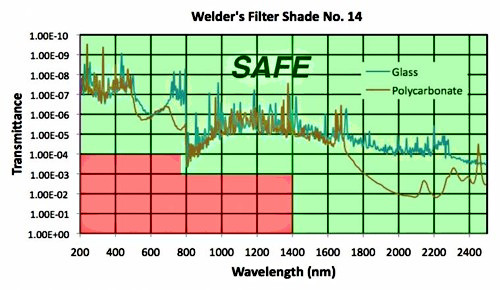
Image courtesy of
B. Ralph Chou and the Royal Astronomical Society of Canada
The safe thing to do is simply to look at projected images of the partially-eclipsed Sun before and after totality. These might be created with a simple pinhole (or series of pinholes)
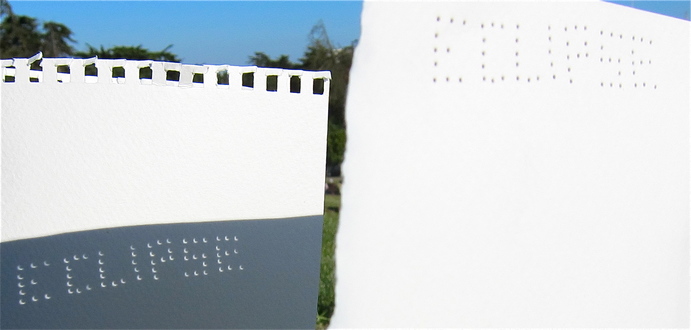
Image of pinhole projection courtesy of
Jenny Oh and KQED
or via the leaves of a tree.
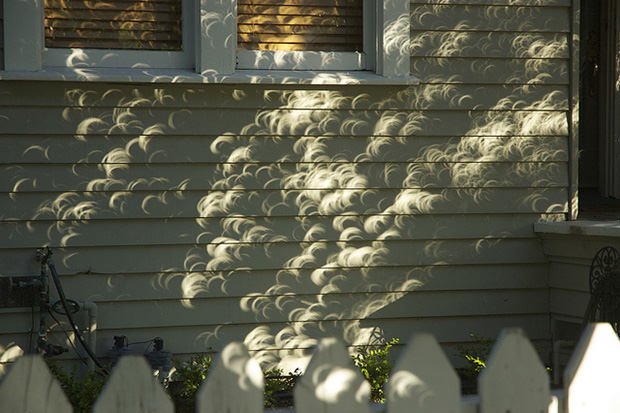
Image courtesy of
J Soffer
If you want to get fancy, you can use a pair of binoculars to project a big, bright image of the Sun.
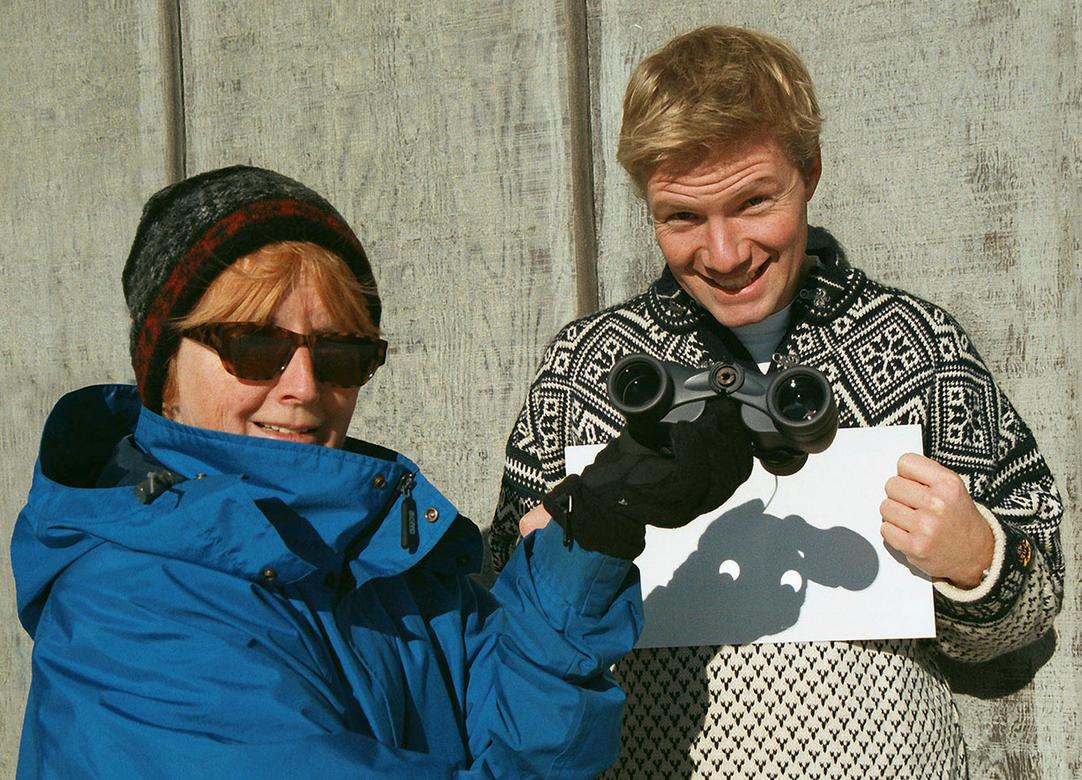
Image courtesy of
Fred Espenek
You could even project MANY images of the Sun using a disco ball! (See also this article by Rapson et al., BAAS, Mar 7, 2024)
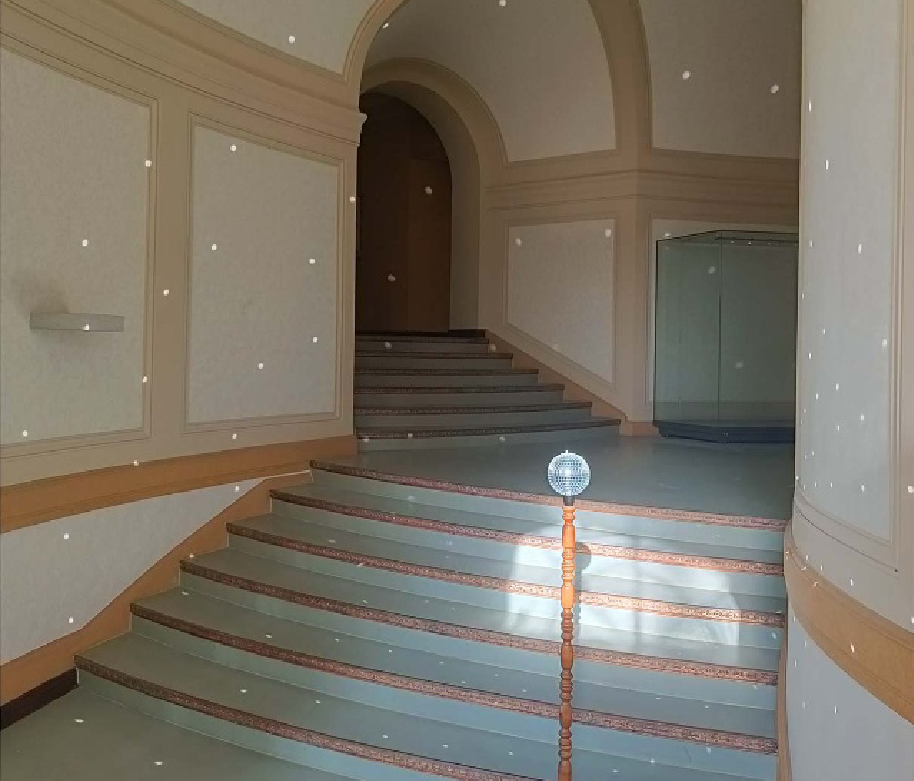
Image courtesy of
Robert J Cumming et al 2024, Phys. Educ. 59 025012 (2024)
I'm planning to use a small telescope to project an image big enough for many people to see at once. It's much more practical than asking people to wait in a long line to look through an eyepiece, and safer, too.
If what I've written so far doesn't persuade you to be careful, perhaps Valerie Rapson of the Dudley Observatory will make a better case. Take it away, Valerie!

Video of eclipse dangers thanks to
RIT graduate
Valerie Rapson
of the
Dudley Observatory in Schenectady, New York
 Copyright © Michael Richmond.
This work is licensed under a Creative Commons License.
Copyright © Michael Richmond.
This work is licensed under a Creative Commons License.